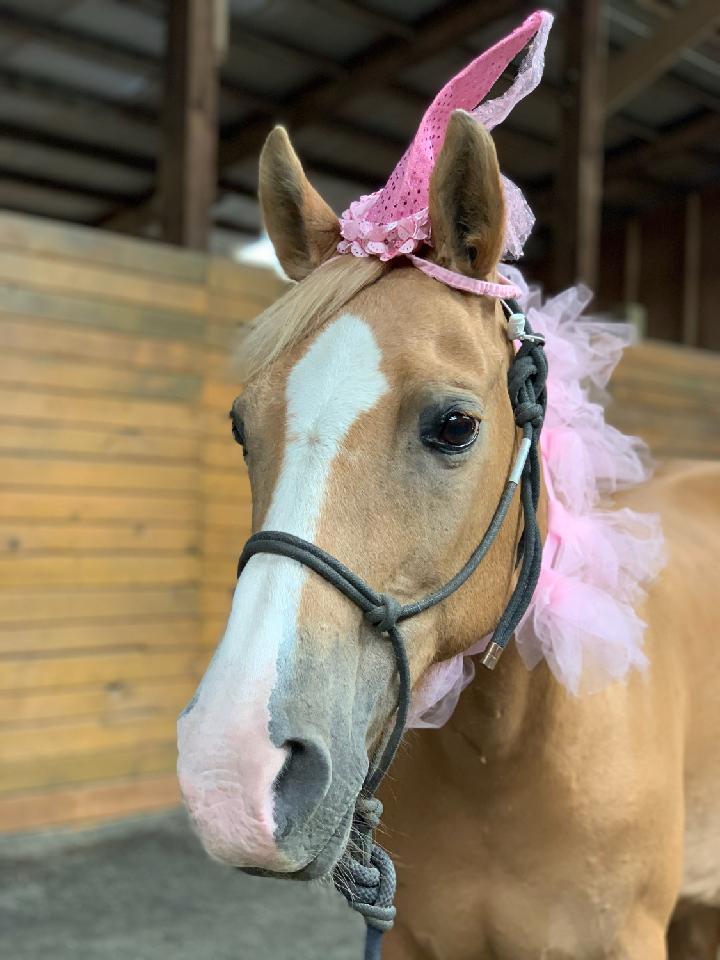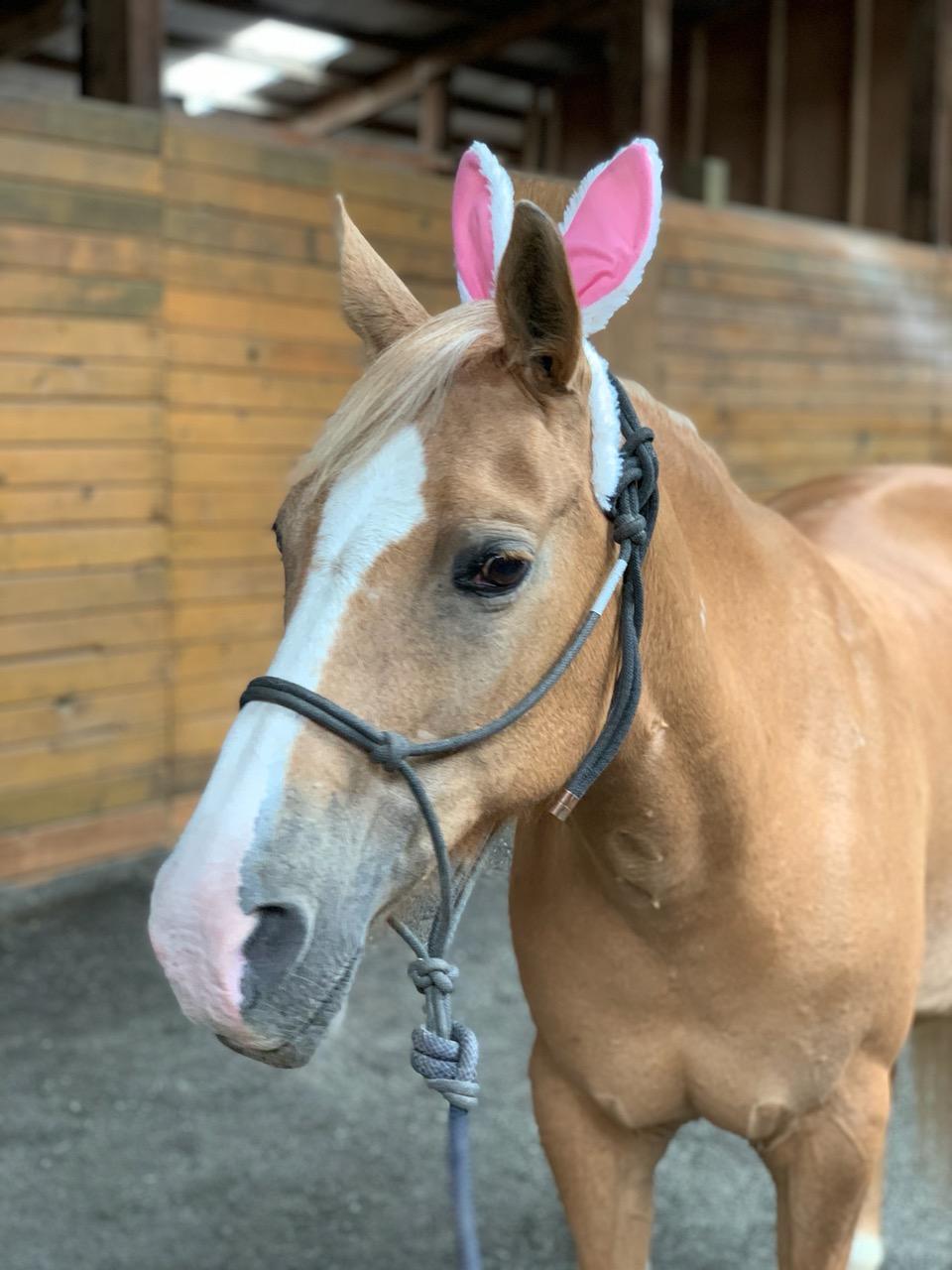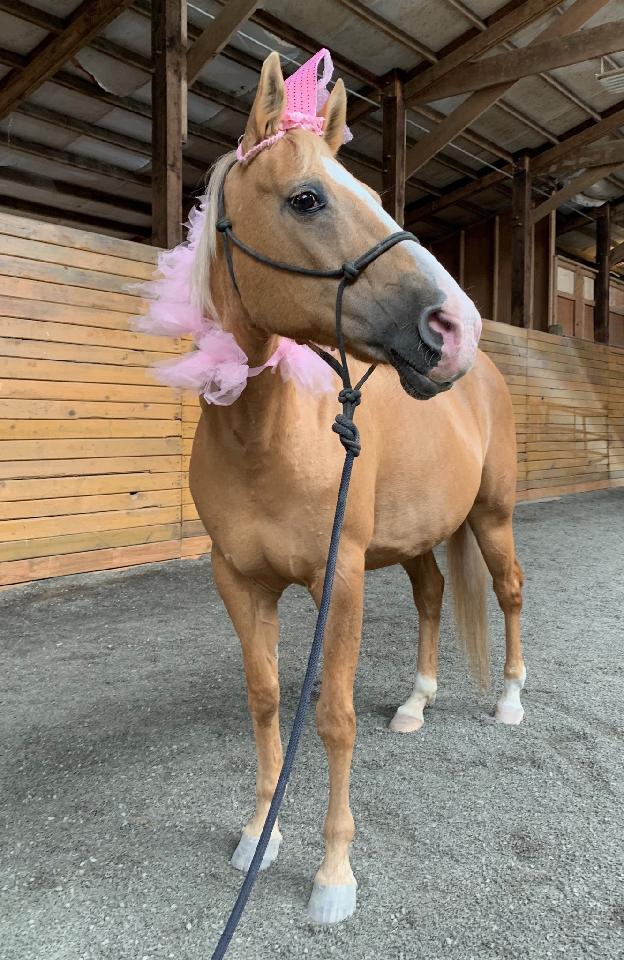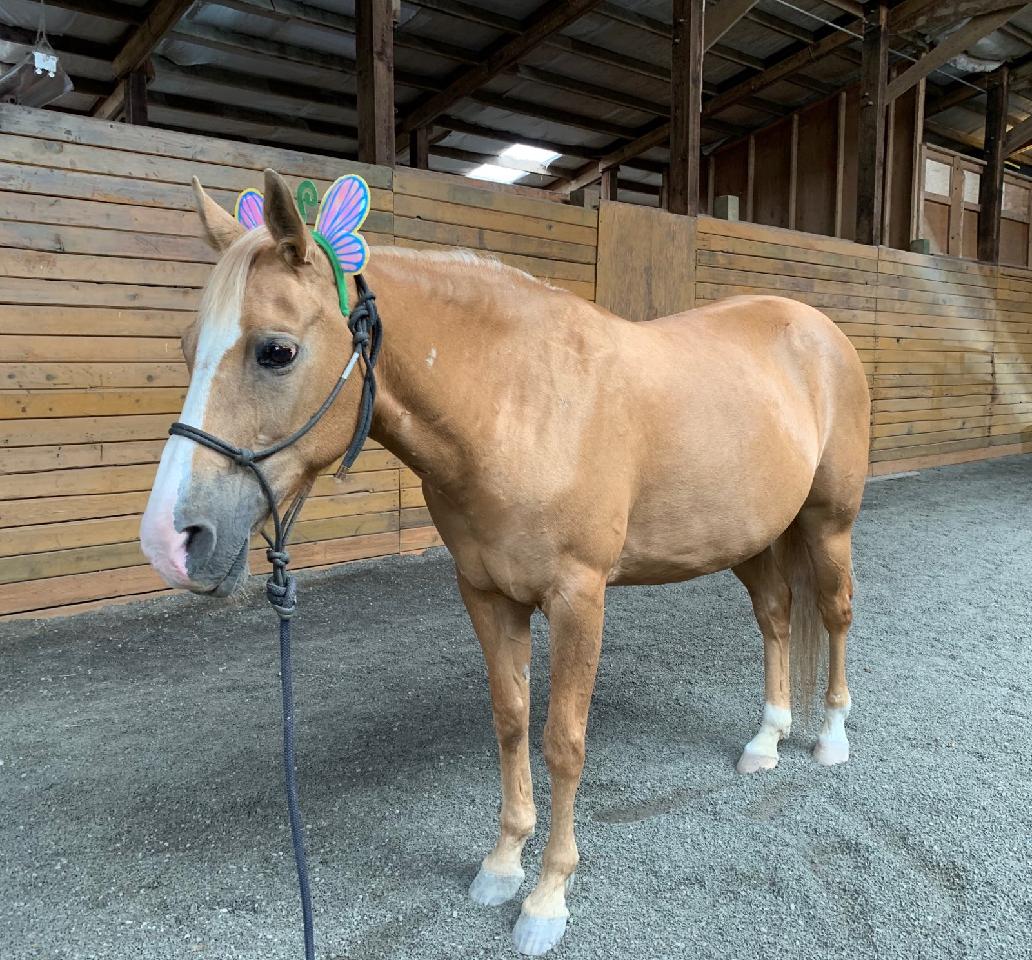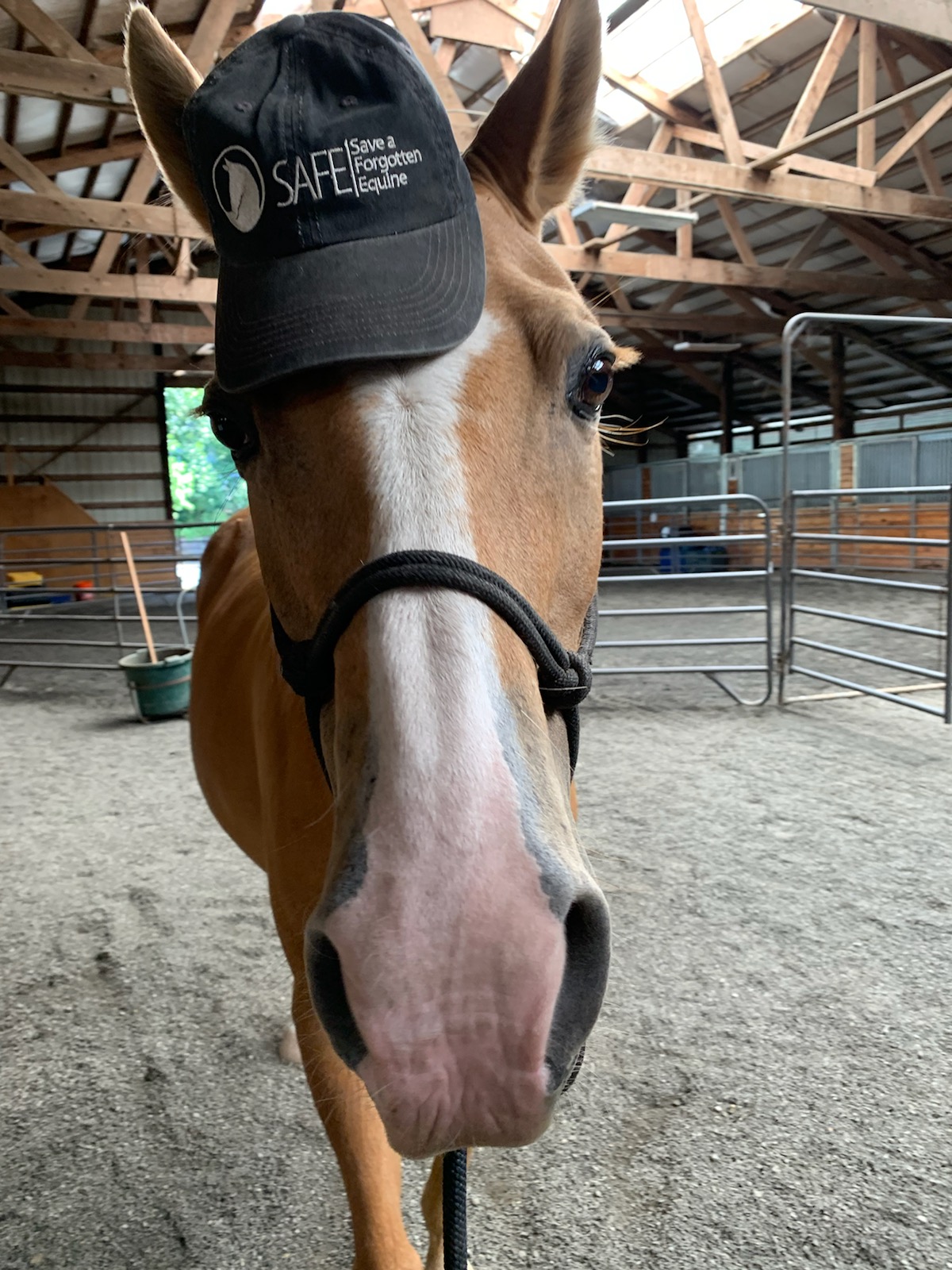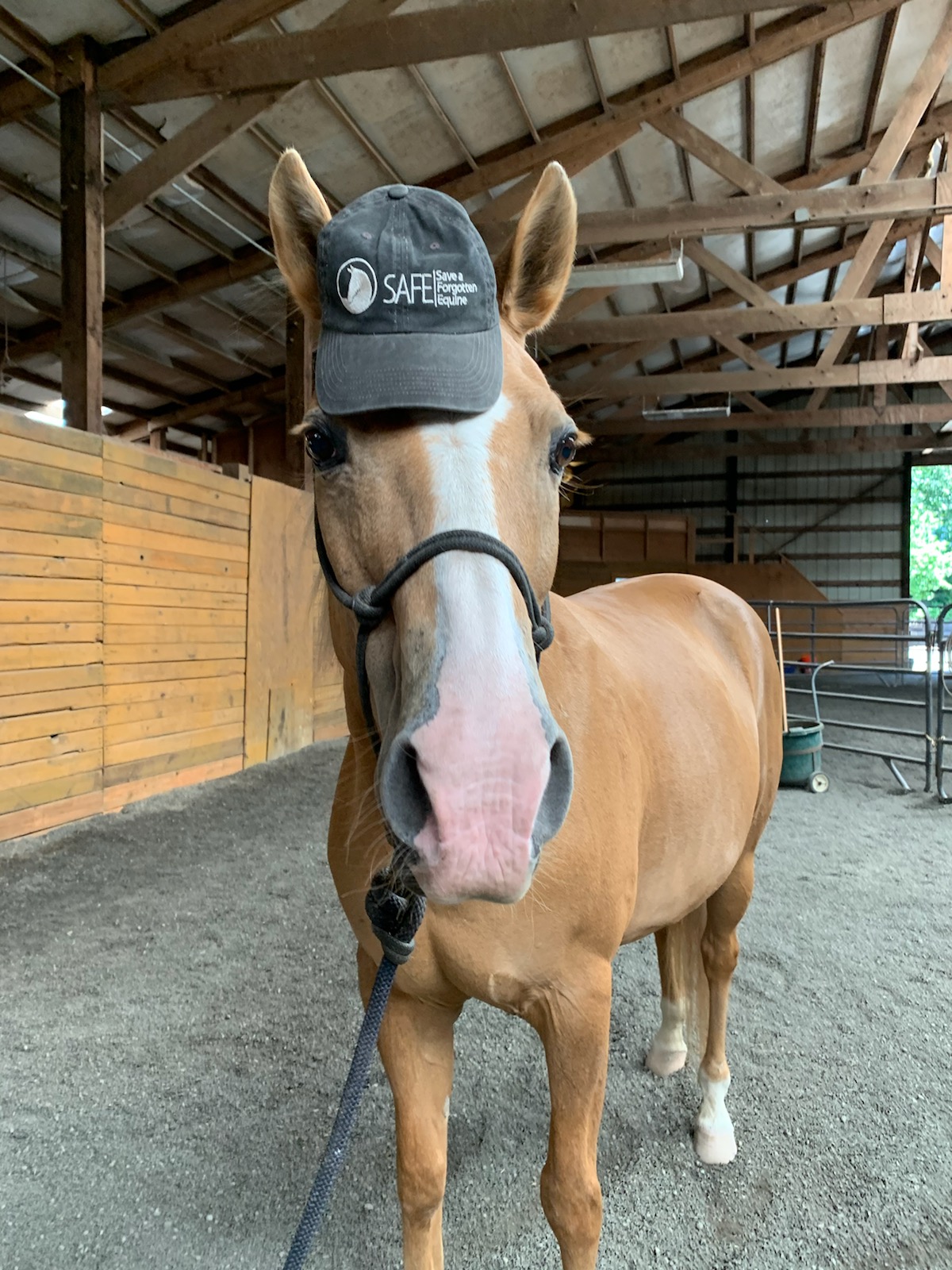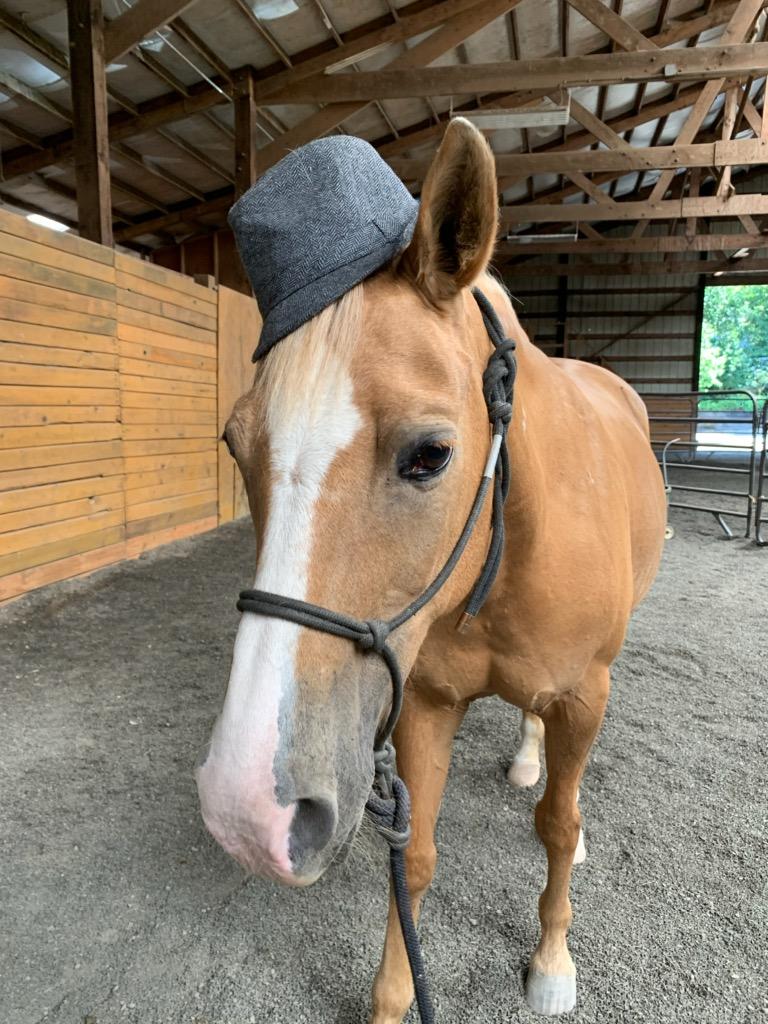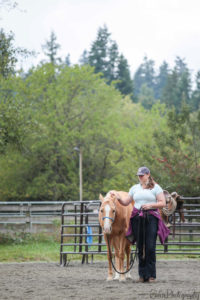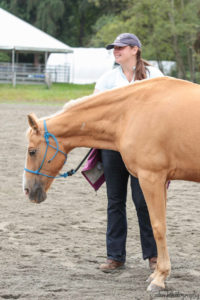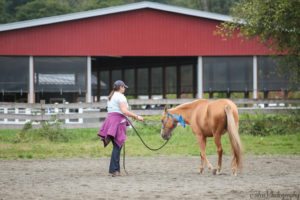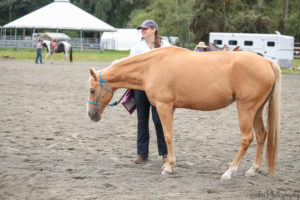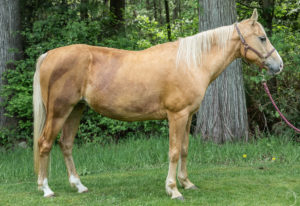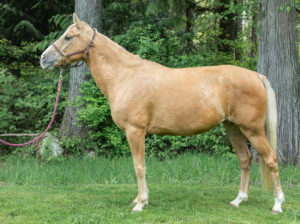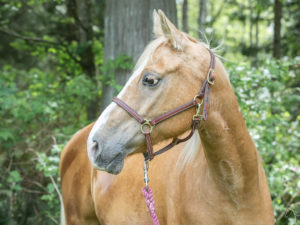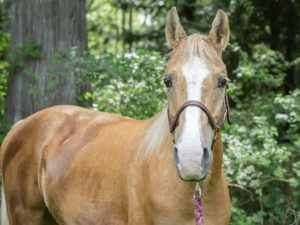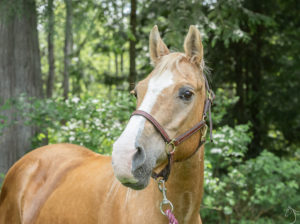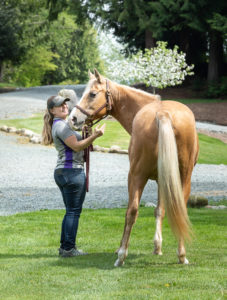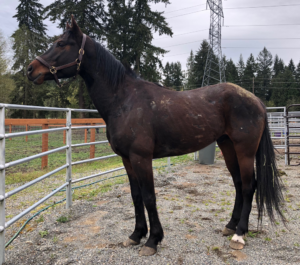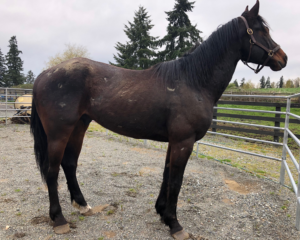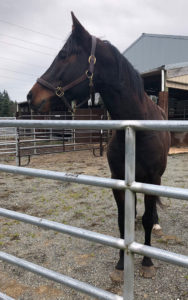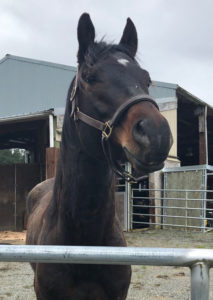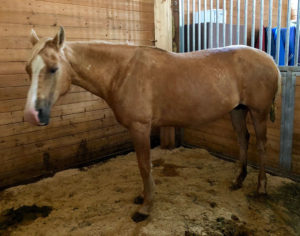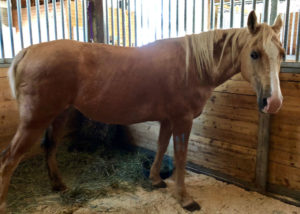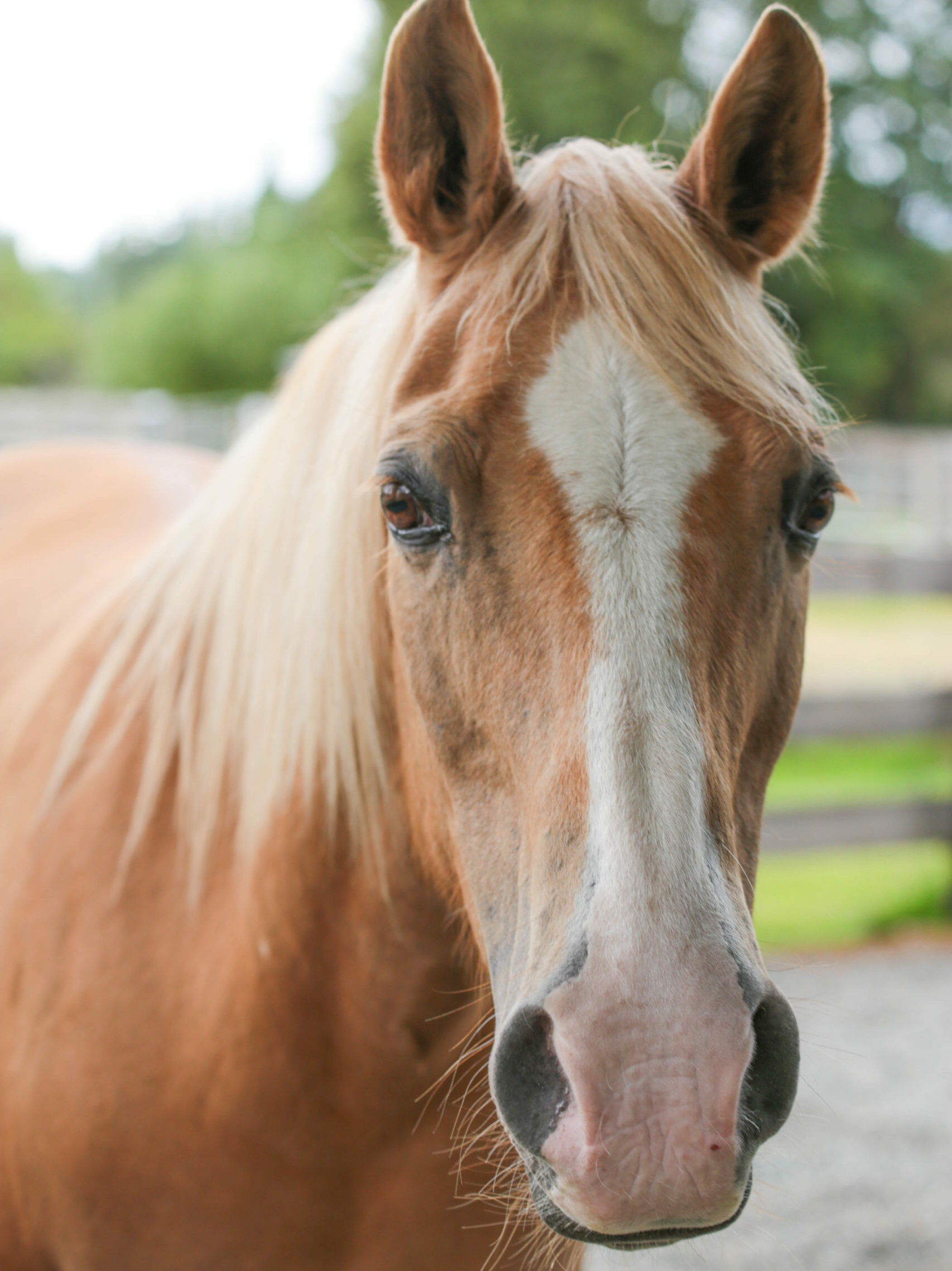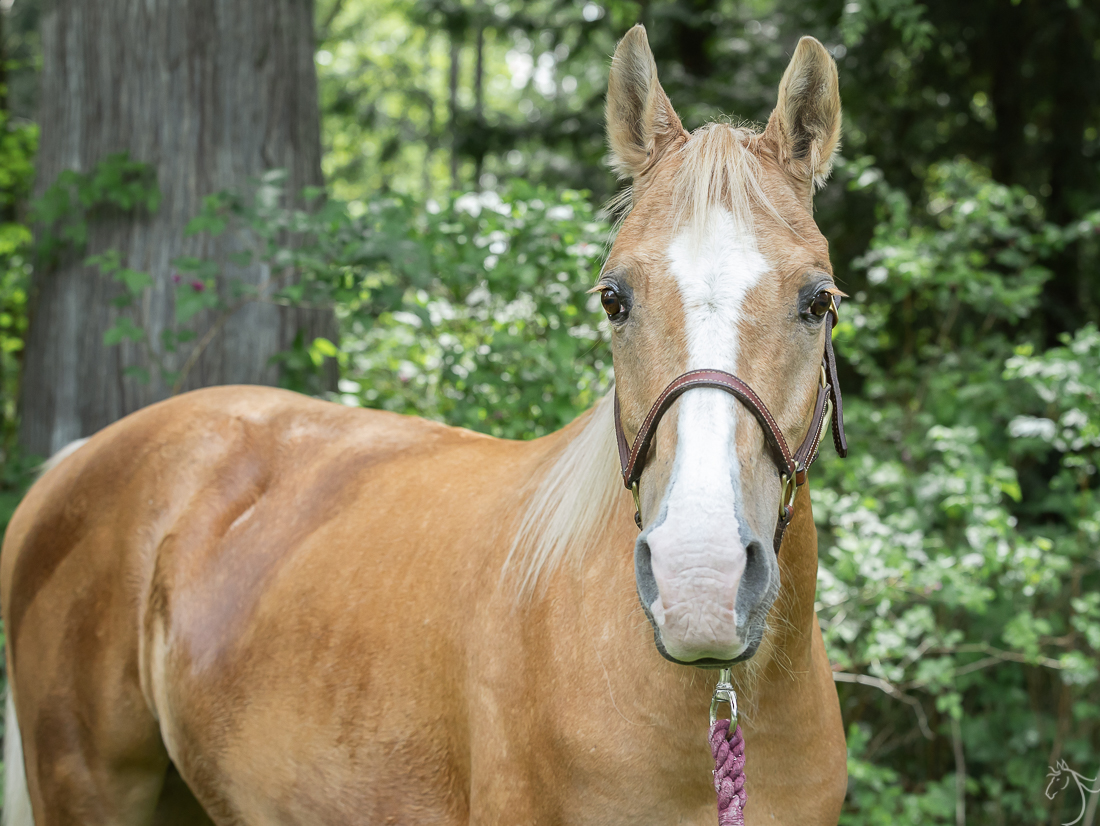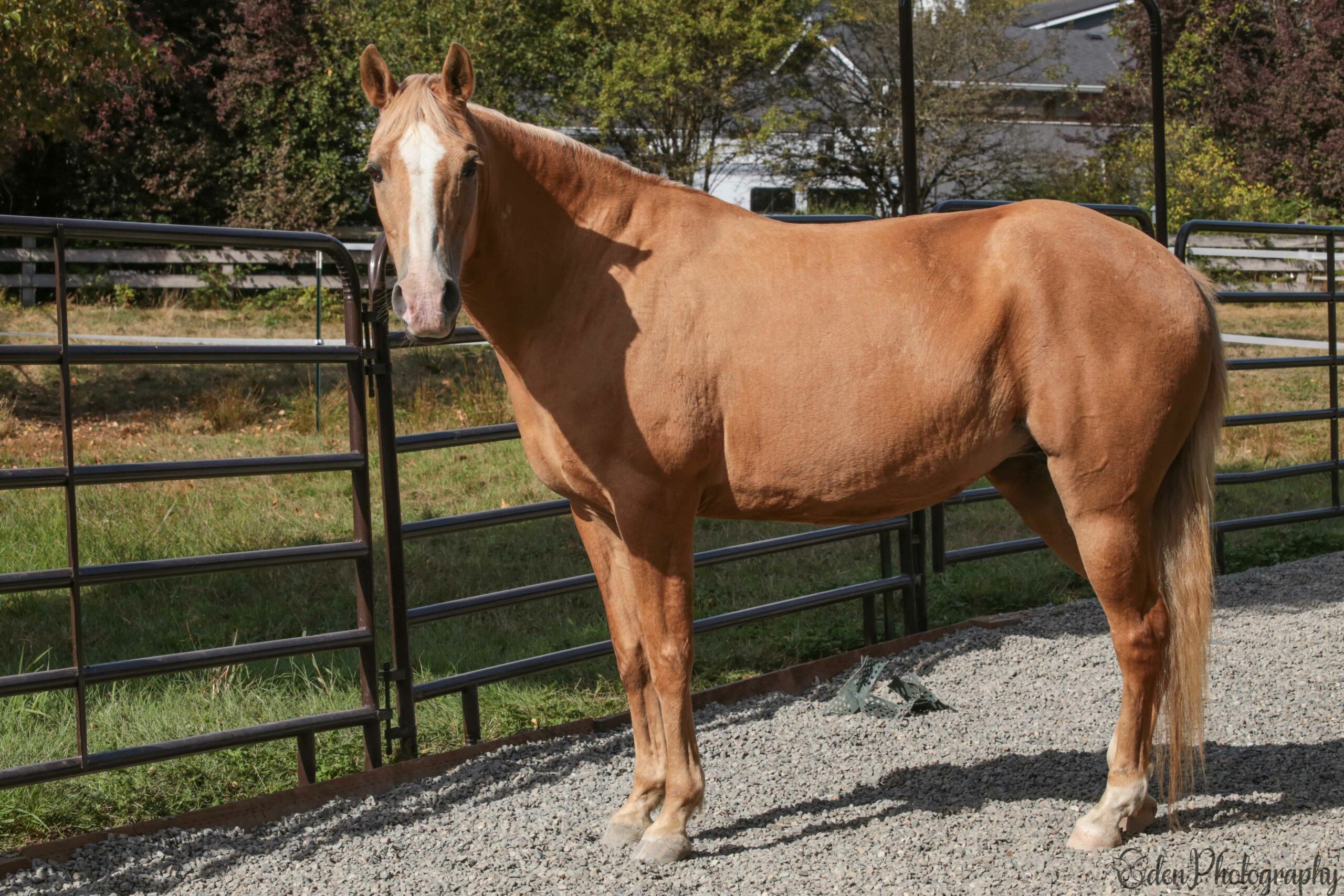Amelia
2000 palomino Quarter Horse type mare
Type of Rescue: Animal Control Seizure
Intake Date: 4/20/2018
Adoption Date: 10/31/2020
Length of Time with SAFE: 2 years, 6 months
Amelia was seized by Animal Control after she was discovered neglected and starving. Upon intake, we initially thought she was pregnant, due to an increase of swelling in her udder, but it turned out that this poor mare had mastitis. She was treated with antibiotics and soon recovered. Amelia was a very sweet mare who loved to be petted and scratched. She came to us a bit starved for affection, and was quite happy to be loved on.
We spent nearly three years with Amelia. We watched her transform from a starved and sick mare into the sassy, happy girl she was meant to be. We battled many health issues with Amelia, including allergies and her ongoing struggle with gastrointestinal inflammation which caused her to colic on several occasions. We worked hard to find the right way to feed her to keep her stable. And we even found her an adopter who loved her and couldn’t wait to bring her home. But it was not to be.
Early one Saturday morning in 2020, we lost our dear Amelia. She had a bad bout of colic that started the afternoon before, and nothing that was done for her could relieve the discomfort and pain she was feeling. Every effort was made, but in the end, we had to make the difficult decision to do what was best for her and let her go.
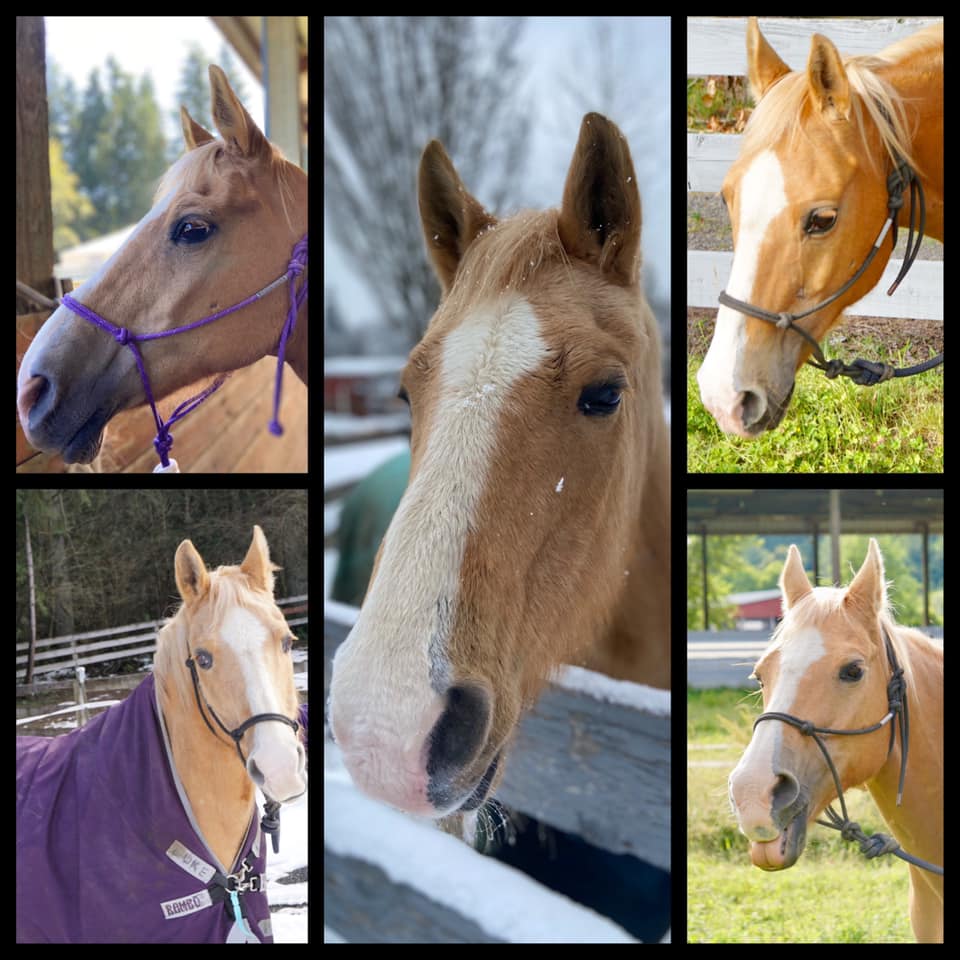
Amelia is gone
We are literally heartbroken to tell you that early Saturday morning, we lost our dear Amelia. She had a bad bout of colic that started midday on Friday, and nothing that was done for her could relieve the discomfort and pain she was feeling. Every effort was made, but in the end, we had to make the difficult decision to do what was best for her and let her go.
This has been deeply painful to everyone here at SAFE for many reasons. We spent nearly three years with Amelia. We watched her transform from a starved and sick mare into the sassy, happy girl she was meant to be. We battled many health issues with Amelia, including allergies and her ongoing struggle with gastrointestinal inflammation which caused her to colic on several occasions. We worked hard to find the right way to feed her to keep her stable. And we even found her an adopter who loved her and couldn’t wait to bring her home. But it was not to be.
SAFE’s mission is to rescue horses that have faced neglect or abuse. But horses like Amelia make us wish that there was a way to prevent neglect from happening in the first place. Because even after making what seems like a full recovery from starvation and malnutrition, horses like Amelia are never completely whole again. Their digestive systems remain more susceptible to food sensitivity, diarrhea, abdominal pain, and colic. For Amelia, we tried everything we could think of as far as feeding to keep her from colic. She couldn’t properly digest any type of hay without colicing and she couldn’t graze on grass without colicing. Right there, two of a horse’s greatest pleasures in life are gone. To keep her comfortable, we had to feed her small servings of pelleted senior feed round the clock. Thanks to iFeed, we were able to deliver her tiny meals 24 hours a day, even outside in her paddock. That solution worked for Amelia…until it didn’t.
Before SAFE, Amelia belonged to an individual who has since been charged with felony Animal Cruelty. Amelia’s case has been pending in Snohomish County for more than two years. The defendant has been able to postpone the hearing over and over again, and there is no way of knowing when she will ever face a judge. If she’s found guilty, she will not be allowed to own horses again for a period of time. But no hearing means no verdict, and meanwhile, innocent animals suffer. It’s an extremely disheartening situation.
Amelia is free from pain, and she will never again suffer from colic. We will miss seeing her bright yellow coat shining in the sun. Amelia was extremely well-loved at SAFE and her death has left a hole in many of our hearts. Rest in peace, dear friend. We’ll never forget you!
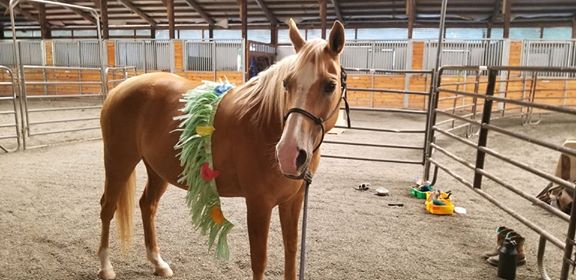
Looking for a Kids’ Horse? Look no further!
Amelia has turned out to be a phenomenal riding partner! Over the last month or so, she’s been ridden consistently in the round pen, the big arena, and out on the trails. She has really shown herself to be a steady, confident horse. She does have a hard time cantering, so we just stick to walking and trotting where she’s sound and comfortable.
Amelia seems ready to be a kids’ horse, with help from parents or a trainer. We think she could even do 4‑H or just be a trail buddy.
We’ve been preparing Amelia to be pampered by kids, so we decided to dress her up to see how she liked it. She was a star! She stood quietly while we threw butterfly wings around her and tried on a million hats and headbands.
Amelia keeps proving herself to be ready for her future best friend! And SAFE is proving that we’re willing to go the extra mile to make sure our horses are ready for anything!! Way to go, Amelia!
NOTE TO ADOPTERS: Please be aware that Amelia is on a special diet to prevent colic — she can’t eat hay or be on grass so she only eats Senior Feed. She eats about 14 pounds of Senior each day, which puts her monthly feed cost at about $200 per month.
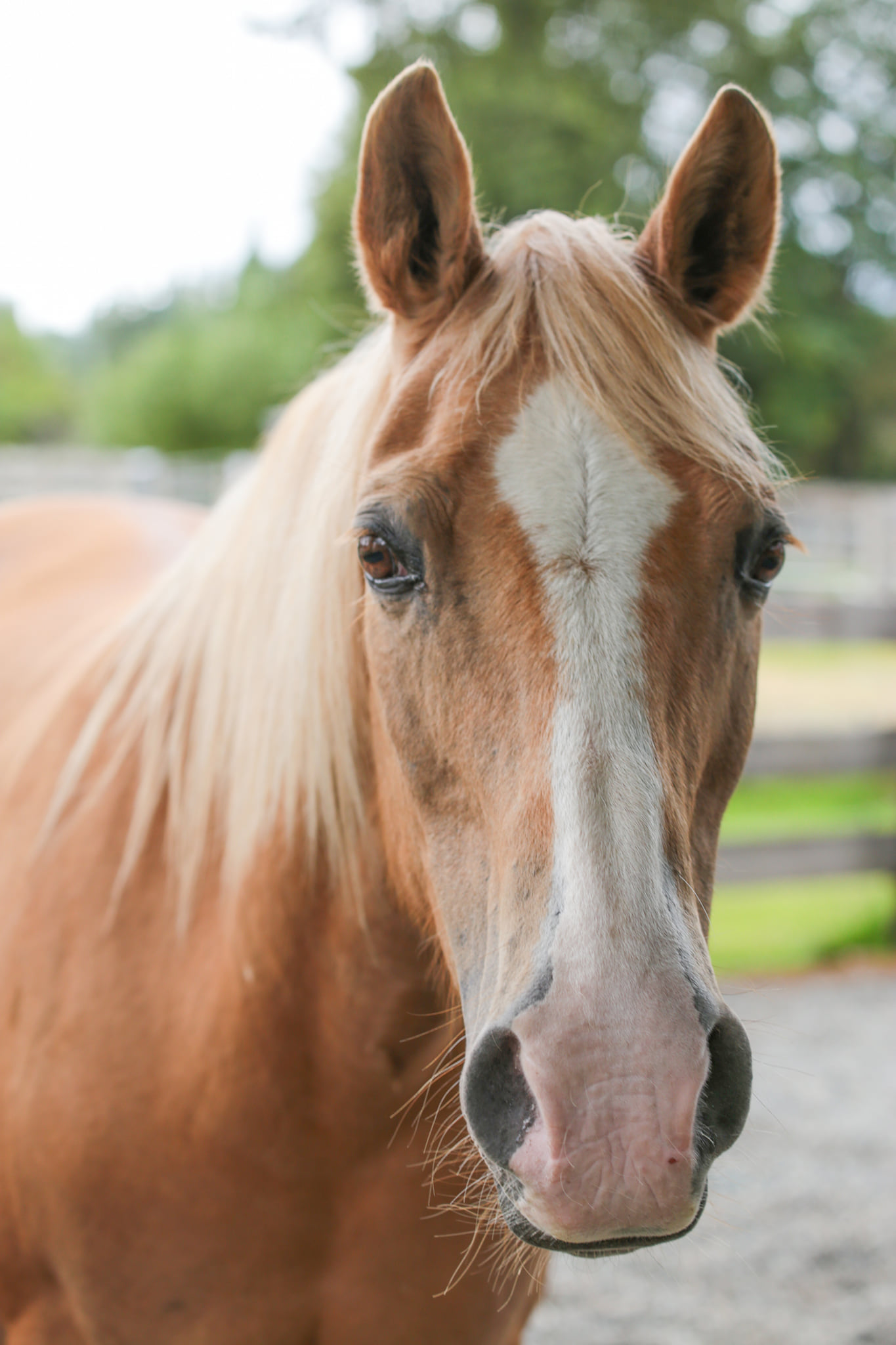
Amelia Gets to Graze!
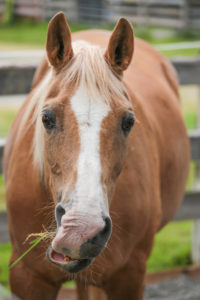 Amelia has been doing very well recently and we have gone several months without seeing any colic symptoms from her. She is thriving on her diet of equine senior that she gets around the clock through her iFEED automatic feeder. After failed attempts to give her small amounts of hay to keep her entertained, we thought we’d try fresh grass since that is easier for her to chew and digest. We started out with just a few minutes per day, and have gradually increased that time as we’ve seen her grazing successfully without any colic episodes. Assuming this continues without incident, we’ll proceed with increasing her pasture time until she is up to the full amount of time that the rest of the herd is getting.
Amelia has been doing very well recently and we have gone several months without seeing any colic symptoms from her. She is thriving on her diet of equine senior that she gets around the clock through her iFEED automatic feeder. After failed attempts to give her small amounts of hay to keep her entertained, we thought we’d try fresh grass since that is easier for her to chew and digest. We started out with just a few minutes per day, and have gradually increased that time as we’ve seen her grazing successfully without any colic episodes. Assuming this continues without incident, we’ll proceed with increasing her pasture time until she is up to the full amount of time that the rest of the herd is getting.
We are also happy to report that Amelia’s allergy shots continue to work like a charm. When she came to us, she suffered miserably from insect bite hypersensitivity. But her monthly injection keeps her happy, and she hasn’t even rubbed her tail this year! You’d never guess she was plagued by sweet itch judging by her appearance now.
With her gastrointestinal and allergy issues under control, Amelia looks and acts like a different horse. Her coat is shiny, her mane and tail are long and sleek, and she’s perkier and more bright-eyed than ever. She’s being ridden regularly by SAFE horsemanship volunteers, and she’s more than ready for a permanent home of her own!
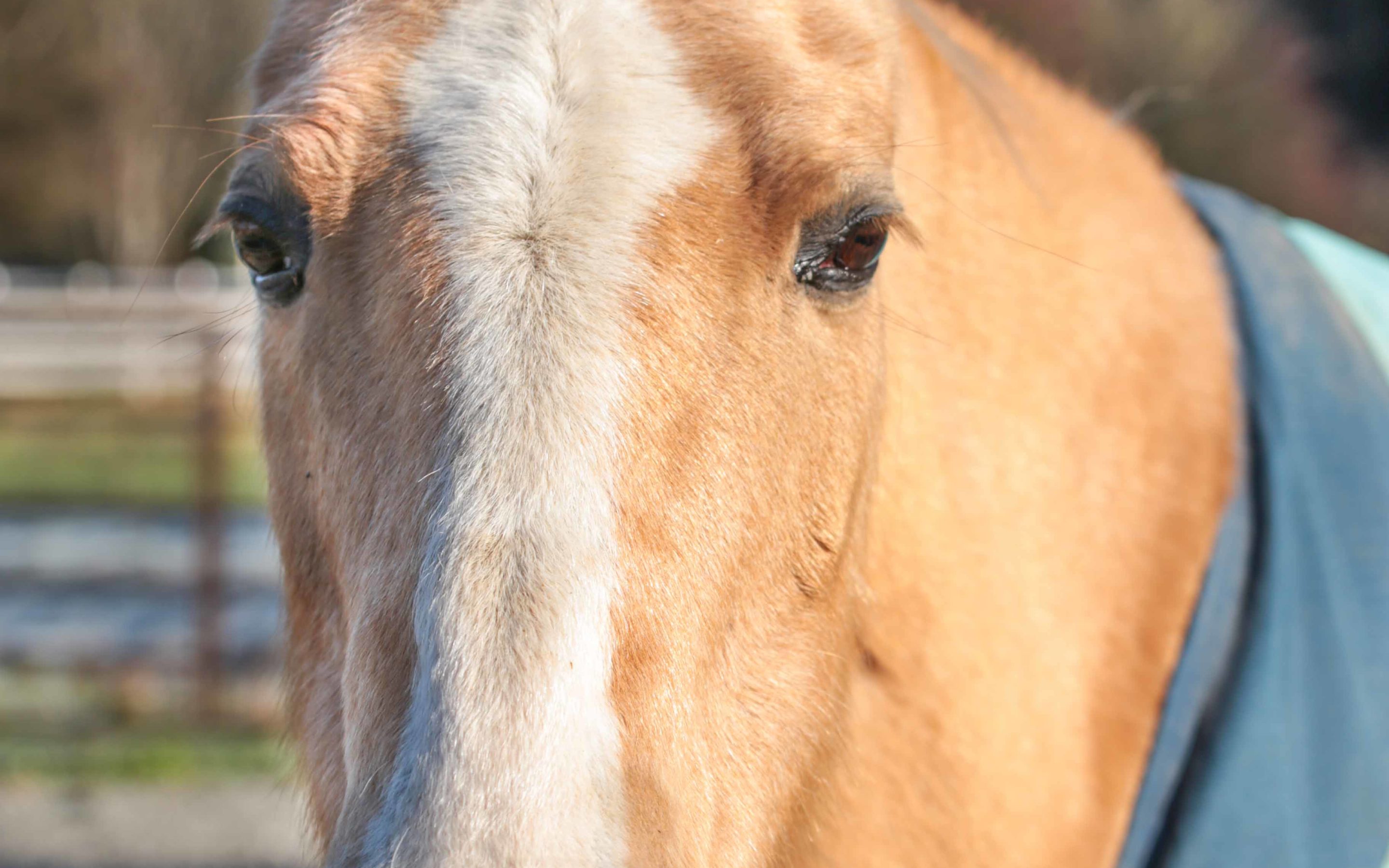
Joel Conner Clinic Update: Amelia
SAFE Volunteer Sarah V shared her experience at the recent Joel Conner clinic:
I had the pleasure of working with Amelia in the June Joel Conner clinic. This lovely little mare has changed so much since we first worked together in the September clinic that Joel didn’t even recognize her! In September we spent nearly the whole clinic trying to get some life into her, but now now she has lots of it! This is largely due to the hard work Melinda and Terry have done to figure out her diet so that she feels better and has been able to gain weight (no more chronic diarrhea!). Her expression is so much happier and more peaceful now, instead of tired and pained.
For the past few months, I’ve been doing groundwork with Amelia and with Casey’s advice was able to get her moving better off of my feel in the round pen, particularly cantering (which was difficult to get her to do before). This involved honing my timing so that I released her as soon as she cantered a single stride, and it worked super well. Amelia is really smart, and soon was readily offering a canter. We then began focusing on getting a more even and relaxed trot, rather than a rushed, panicky one, and working to get smoother transitions between the gaits.
Kaya also recently began working Amelia on the days I wasn’t at SAFE, and started doing groundwork with her saddled. She helped me work on getting Amelia less bothered by noise/movement from the saddle area, less cinchy/grumpy about having her chest and barrel rubbed, and more bent and “with me” on the unified circle, and this really showed in the clinic.
I’m still learning so much, and it felt like the first few days of the clinic were focused on getting my angles right when for asking for hindquarters/front quarters, and building my confidence that I could send Amelia with my feel, rather than getting too close to her. It was a huge change when I was able to take one step towards her hindquarters and get her to move completely away from me. We’re still working on getting her more fluid in her hind and front quarters, but I’m hoping the things we learned at the clinic will help me to continue improving on this with her.
When we turned her loose in the round pen, Amelia was initially cutting close to me and not staying on the rail, so Joel explained how to “Make the wrong thing difficult, and the right thing easy,” which in this case involved making her work/putting on the pressure on the side by the gate where she wanted to be, and making the side she was cutting off the place where I would release all pressure. Joel got some great changes with her using this technique. I’m still working on providing my release at exactly the right time and not too late, but there’s already a big difference.
By the end of the clinic, both Joel and Kaya had ridden Amelia while being flagged around, and she was doing nice one-rein stops. This horse, who’d had a difficult time backing up, moving with life, and not “checking out” during work, was now moving out more freely and with energy, gaining balance and starting to search for a release from her handler and rider.
We’ve got a lot of takeaways to work on from this clinic, and I’m so grateful for the chance to work with Joel, Kaya, and Terry on Amelia. Her expression and energy are just so sweet and lively now. It’s a joy to see the change in her and I can’t wait to watch this mare continue to develop into a riding horse.
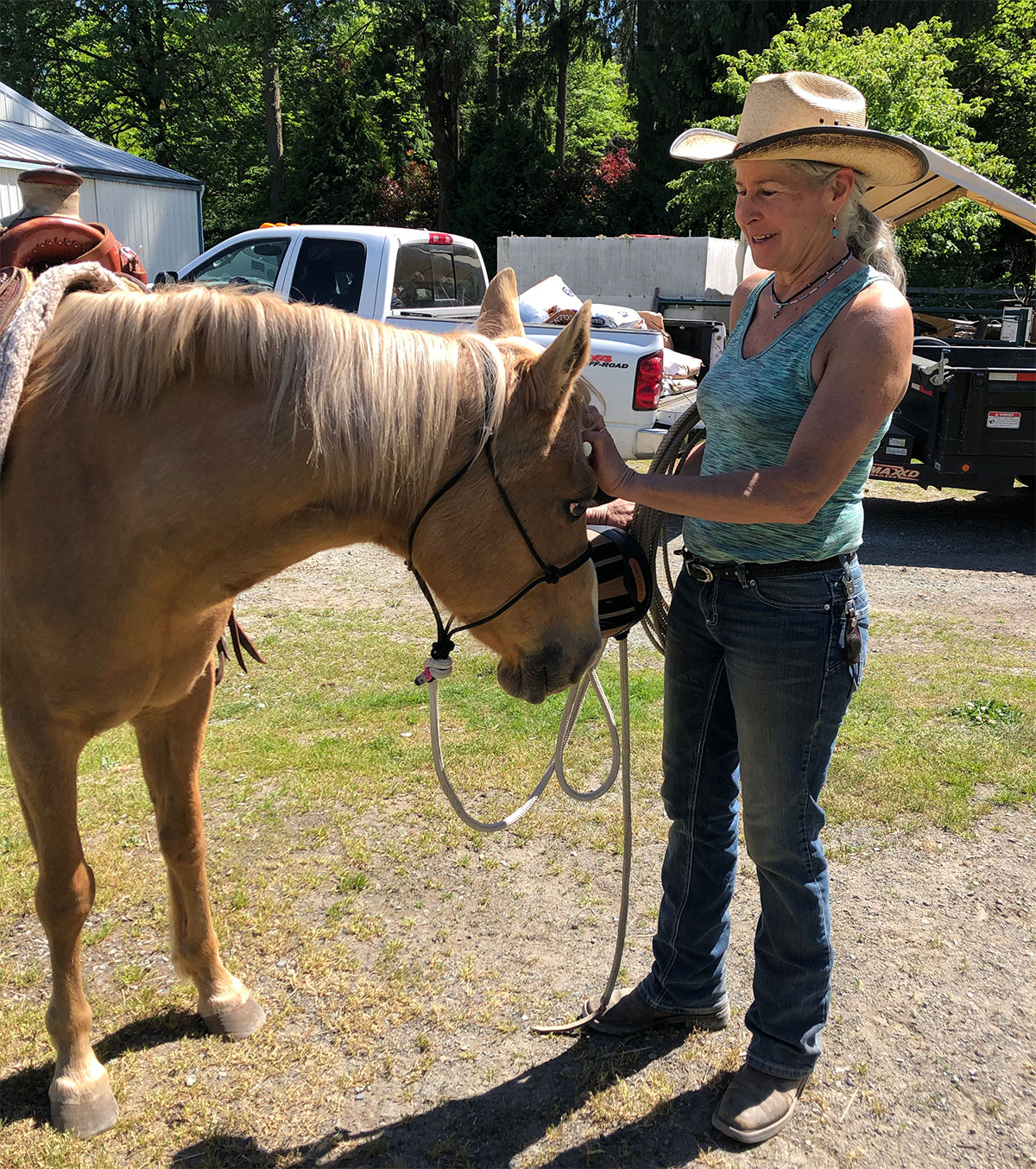
Amelia Under Saddle
SAFE volunteer rider Phoebe has been working with Amelia for quite a long time, and has successfully restarted her under saddle. Though Amelia will only be suited to light riding due to her age and history, she loves kids and would be a great horse for leadline.
Amelia is under saddle and doing great! It has taken a while for her to understand that her mouth won’t get pulled on, but she is now accepting the snaffle bit in less time than when we started. She has gone outside the arena now, with her ears pricked forward. She has been amazing. This is not her first rodeo and definitely something she enjoys. Trails are next!
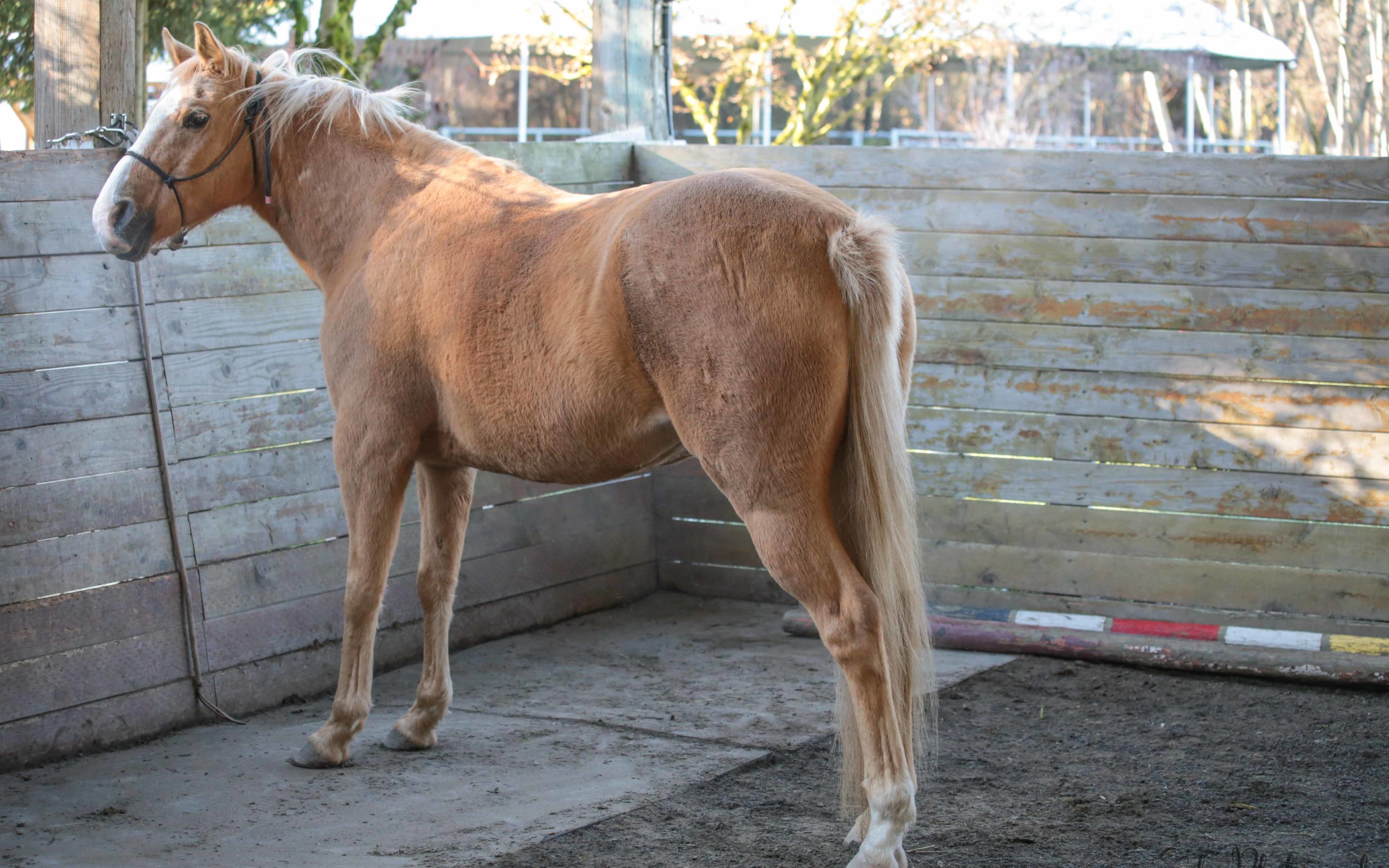
If Horses Could Have Dentures: Amelia’s Dental Update
We are now two months post-colic for Amelia and we’re pleased to say that she’s doing great! We haven’t seen any signs of pain from her for some time. Shortly after she returned from the hospital, we still saw minor signs of discomfort, but those have disappeared.
Amelia still tries to eat her shavings if we bed her stall too heavily (meaning anymore than just enough to soak up urine), and she has recently decided that she wants to eat the wood fencing in her paddock. She’s at the perfect weight and her coat is looking shinier than ever so we know she’s getting enough nutrition from the equine senior feed, but it’s just not enough to satisfy her urge to graze. We consulted with Dr. Lewis, who suggested we try adding hay slowly back in to her diet in hopes of making her a little happier. We started with one pound of timothy hay, but stopped when we realized that Amelia couldn’t chew it. We knew she had the teeth of a much older horse, but the last time we saw her eat hay she did it without an issue. An oral exam was scheduled, and Dr. Renner came out to see her.
Upon looking in her mouth, it was immediately obvious to Dr. Renner that Amelia’s days of chewing hay as a means of getting nutrients are over. She no longer has enough grinding surface in her mouth to adequately process it. Luckily he did say that she can have small amounts of hay to keep her entertained (assuming her GI system tolerates it without colicking), we just won’t expect her to get much in the way of calories from it because she spits it out again after chewing it for a while.
We’ve decided to try feeding her local grass hay, which is soft and easier to chew, in a hay net with very small holes so it will last her a while. We’ll stick with just a pound of hay to start and see how she tolerates that. So far she seems very happy to have a little something else to munch on! If she does fine with this pound each day for a while, we will add a hay net to her stall so that she can keep herself busy overnight. And once that happens, she can even go back to having a normally bedded stall because we won’t have to worry about her eating her shavings. These are all good things!
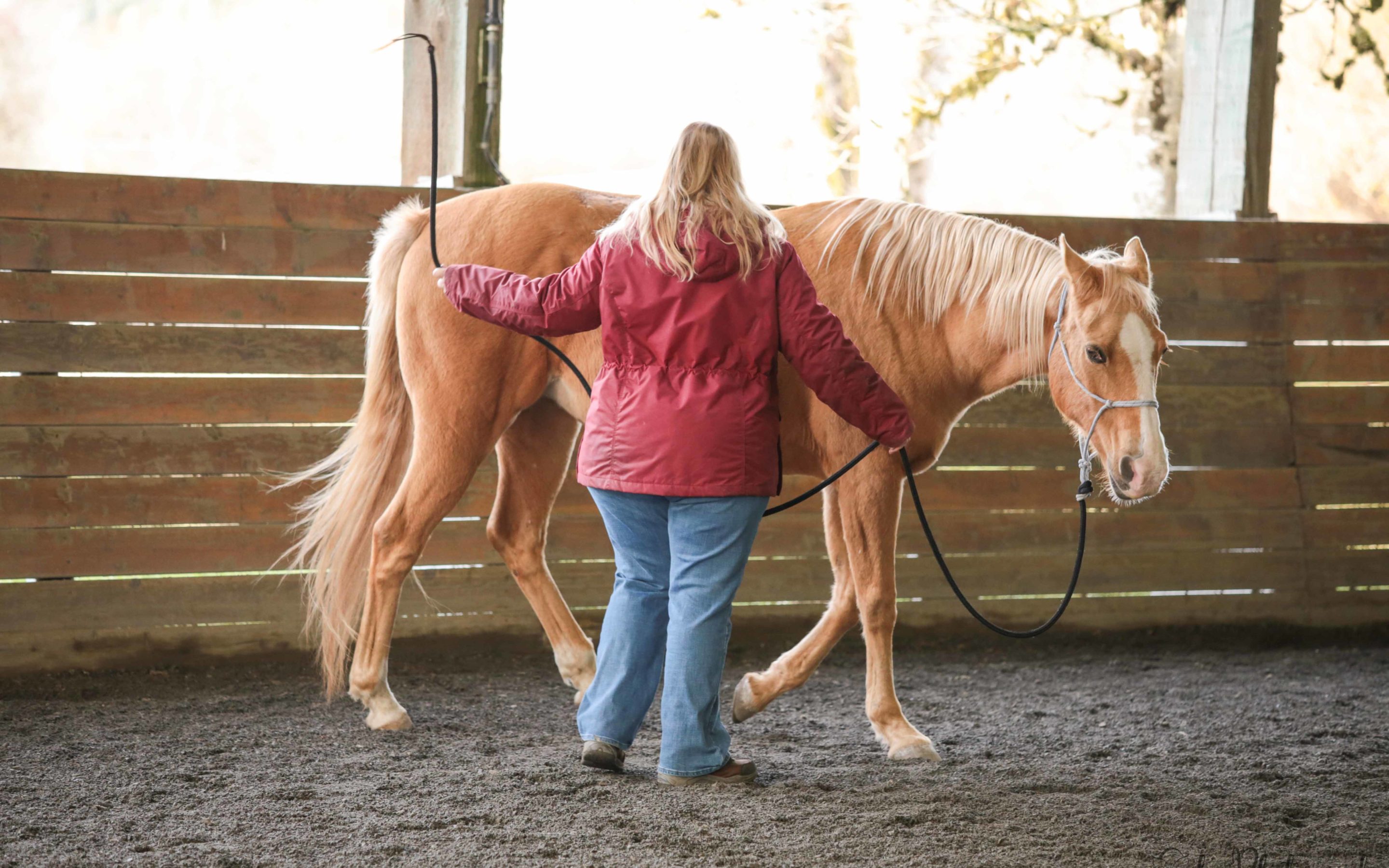
Amelia: Joel Conner Clinic Report
SAFE volunteer Jennifer A got to work with Amelia on the ground at the most recent Joel Conner clinic. Here’s what she had to say about the experience:
I was so excited for the opportunity to work with Amelia at the Joel Connor groundwork clinic. It was my first time as a participant. I knew Amelia had a tendency to crowd and push during turnout and was hoping to work on moving her out during the three days. Amelia is such a cuddler and I soon discovered that she uses that as a distraction for her handler.
I spent a lot of time in the clinic working on backing her up from a distance and did eventually get to a softer feel. She is great at backing when I hold the halter knot. Amelia is slow and methodical at working the front and hind quarters, but she knows what to do and was incredibly patient while I was learning. She can be stubborn and does require some firming up to get started, but quickly responds to the release. I learned that I needed to use more energy to get her moving.
Amelia progressed a lot during leading. She moved out and was responsive to the stop and backup on the right (her left), but lacks confidence when on the left (her right). She would lag behind and try to cross behind me. We worked on leading at different speeds and she showed a lot of improvement in a very short period of time. Much to my surprise, Amelia was responsive at moving into the trot and didn’t require much energy to get her moving. By the third day Amelia was moving out and allowing me plenty of personal space during rest and while working front and hind quarters. I absolutely love this mare and feel honored that I have earned her trust.
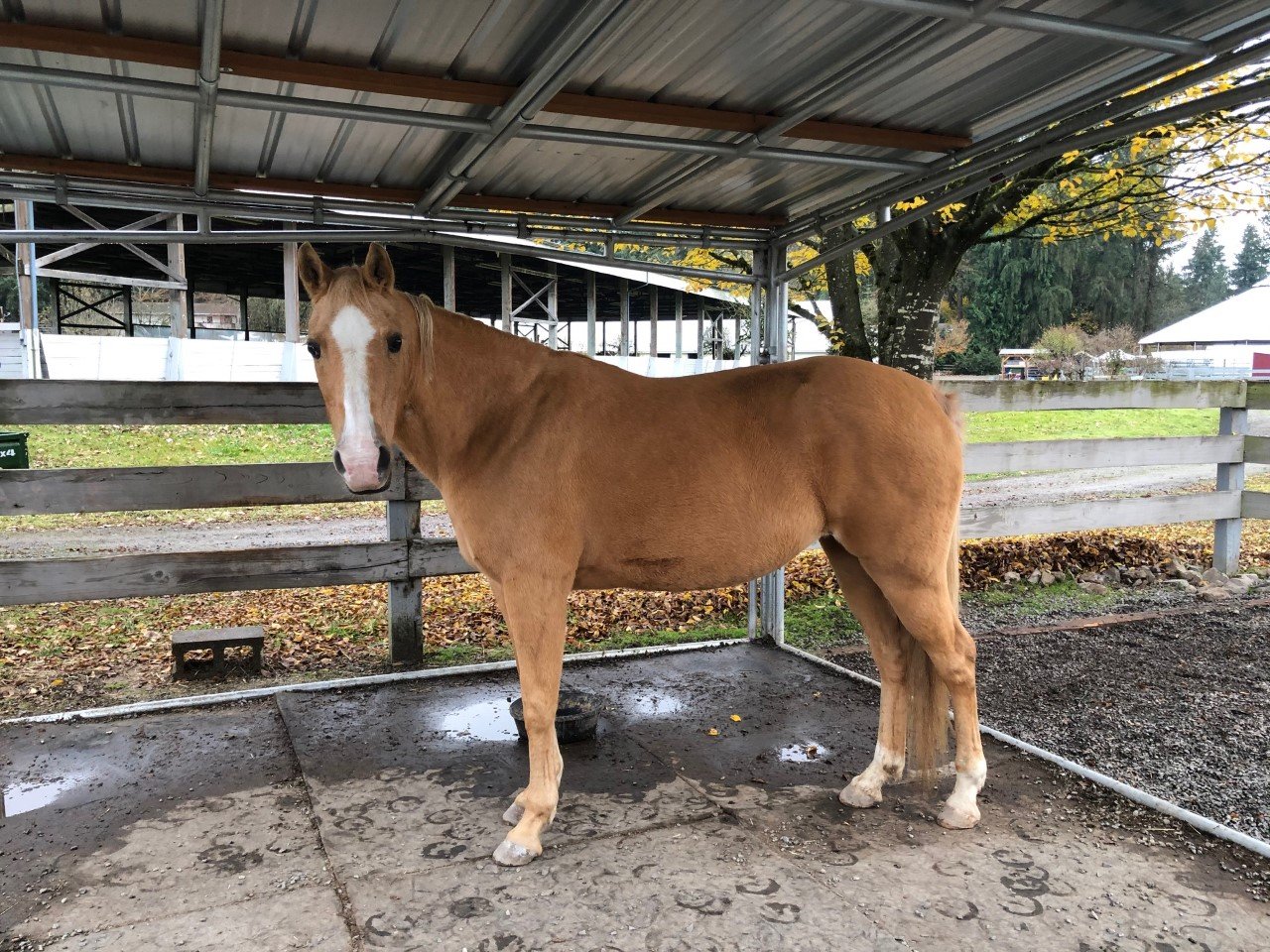
Amelia’s Trip to the Hospital
Sweet Amelia has battled GI issues since before she arrived at SAFE. But so far, we had only seen her have one colic episode, and it was a minor one. But just before Halloween we found her down in her turnout, not wanting to get up. She hadn’t finished her most recent meal, which is very unlike her. She was given a dose of oral banamine, which did nothing to make her feel better. When it was clear that this wasn’t going to go away without veterinary attention, Dr. Lewis from Rainland Farm Equine Clinic came out to see her.
The strange part about this colic episode was that Amelia’s heart rate barely increased above normal range. An elevated heart rate while at rest is a typical giveaway that a horse is in some sort of discomfort. She wasn’t pawing, she wasn’t rolling, not doing most of the typical things you usually see in a horse who’s colicking. If she hadn’t gone off her feed and been lying down at a strange time, she might not have even drawn much attention to herself. But when you took a close look at her you could see that she was clearly uncomfortable. Dr. Lewis’ exam was fairly unremarkable, until she passed the nasogastric tube to administer fluids and electrolytes. Before adding anything into the stomach, veterinarians will check for stomach reflux in a horse. Presence of large amounts of fluid in the stomach is abnormal and indicates that there’s something causing the small intestine to not function properly. In Amelia’s case, she had a large amount of reflux present.
Dr. Lewis removed as much reflux from Amelia’s stomach as she could, and then performed an abdominal ultrasound. The ultrasound showed distended loops of small intestine. Because Amelia did not seem to be in excruciating pain, as you would likely see in something that would need surgery like intestinal entrapment or volvulus (twist), Dr. Lewis believed we were probably dealing with an enteritis. Enteritis in a nutshell is inflammation of the intestines. This was good news, because it meant that most likely Amelia was not facing something that could only be resolved with surgery. Dr. Lewis pulled blood, gave Amelia a dose of intravenous (IV) pain meds, and left the nasograstric tube in place. In this type of situation, the stomach will continue to fill with fluid and, because horses cannot vomit, the reflux will need to be removed on a regular basis until the problem resolves. This is something that I am able to do in house thanks to my training as a veterinary technician. As long as Amelia didn’t continue to get worse, we could try to manage her at home rather than hospitalizing her. I made plans to spend the night in the barn with Amelia and reflux her every 2 hours.
Dr. Lewis left SAFE and went back to the clinic to run the bloodwork. She called me a while later to check in. When I told her that the IV banamine and refluxing did not seem to improve her comfort level, we decided to haul Amelia to the clinic to be put on IV lidocaine. Lidocaine is a pain medication and can also improve gut motility. The dosage is very specific though so it needs an electronic fluid pump in order to administer it. Because of this, she would need to be transferred to the clinic. Amelia hopped into the trailer like a pro and we made the short trip to Rainland.
Upon arrival, Dr. Lewis placed an IV catheter and Amelia was put on fluids and started on lidocaine. I was allowed to still stay the night with her and continue to do the refluxing. She was producing so much reflux at that point that Dr. Lewis had me do it every hour instead of every 2. The worry with that is that the stomach can rupture if it’s allowed to become too full. Amelia was clearly not out of the woods, but we were doing everything we could for her.
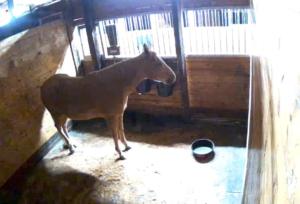
Our view from the webcam
By about 3 AM, I had stopped being able to get much reflux out of her. Amelia was turning a corner in the right direction. She continued to get brighter and eventually the nasograstric tube was pulled and the IV fluids were stopped. She would spend the next two days at the clinic. One day for observation and allowing her GI tract to continue to settle, and another day to see if she could handle the re-introduction of food.
The remainder of her hospitalization was uneventful, and she handled the re-feeding well. She was discharged with a couple of medications and instructions to feed her a pound of equine senior every 2 hours. We set up the iFEED automatic feeder in her stall so she could have continuous feedings throughout the night, and we also placed our webcam in the stall so that we could monitor her after hours. We were also told to watch her closely for eating anything she shouldn’t be, and to make her wear a grazing muzzle if she did. Even though she is getting enough food for her weight, just getting a pound of feed per feeding doesn’t leave Amelia feeling very full so this was a concern. Without fail, the first thing she did when she was allowed turnout was start eating the leaves on the ground, so she earned herself a muzzle for turnout. She didn’t bother to eat the shavings in her stall for the first week or so that she was home, but eventually she began eating those, too. She can’t wear the grazing muzzle overnight because it doesn’t allow her to eat from the feeder, so we were left with no choice but to strip her stall of all the shavings.
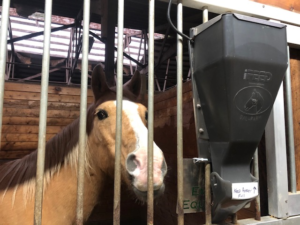
Amelia loves her iFEED!
Amelia’s official diagnosis was anterior enteritis. We will likely never know exactly what caused it. If she continues to have issues in the future, we may have to take her to Pilchuck Veterinary Hospital for an internal medicine consult. But for now we’ll continue to monitor her closely and keep our fingers crossed that this was an isolated incident. We’re happy to have her home.
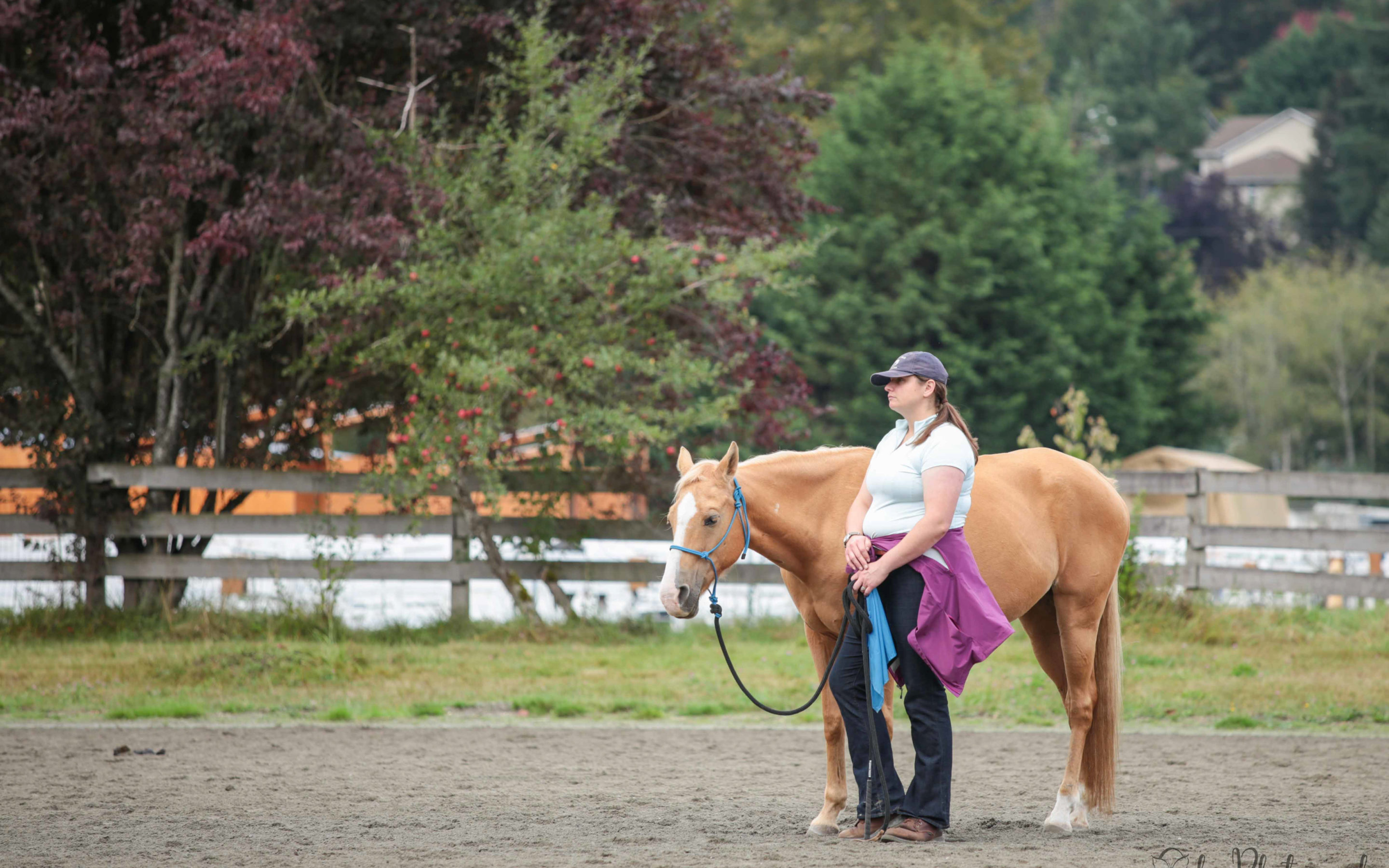
Amelia: Clinic Update
Sarah V worked with Amelia in the September clinic. Here is what she had to say about getting to know this sweet mare:
Amelia and I had only worked together once before the clinic and I’m still new to this style of horsemanship, but she was a lovely mare to work with and incredibly patient with my learning. During the two groundwork sessions, we focused primarily on feeling out how much of my energy was required to get her to move her feet, and also getting her to respond promptly to that energy. Because of some arthritis and a lack of conditioning, Amelia has some difficulty bending to the left and backing up, so we worked primarily on moving her hindquarters and then backing her from both a distance and next to her head. She also has a slight tendency to push into her handler, which meant we worked on preserving my space and keeping her shoulder out while on the unified circle.
Knowing Amelia’s history of neglect prior to coming to SAFE and that she had some arthritis/weakness and being new to working with her, I erred on the side of caution in not pushing her too hard, and later realized I wasn’t asking for enough of a release to help her let go of her braces and get unstuck. By the end of the clinic, though, Amelia was more prompt with her upward transitions and backing up, more respectful of my space, and a bit less stuck in her feet. I look forward to working more with Amelia to work through some of her braces and free her feet, build her strength, and continue increase her responsiveness.
An Answer for Amelia: Health Update
Troubleshooting Amelia’s stomach problems has been an ongoing struggle since we got her. She’s only had one minor colic episode, but she has had off and on loose stool from the get go. We’ve tried all sorts of things. She’s been on different probiotics, elimination diets, metronidazole, allergy medication, and we’ve had all the recommended bloodwork and fecal tests done.Sometimes we think we’ve found the answer when her stool goes back to normal for a while. But then the diarrhea comes back and we’re back to square one.
The most recent suggestion from our vets was to haul her to the clinic for a gastroscope to check for stomach ulcers. Since this is a bit of an expense, we try to exhaust other options before scoping a horse. But our options were exhausted with Amelia. She spent a night at Rainland last week and was scoped the following day.
The good news for Amelia is that she does not have a diagnosis of gastric ulcers. No major issues were found. But Dr. Fleck did find some mild irritation on her stomach lining. It was recommended that we take Amelia off of forage completely for 2 weeks to see if that calms her GI tract down, so she has been started on a diet of equine senior feed. We tried this before at the recommendation of Dr. Renner the last time she was examined, but equine senior has ingredients in it that Amelia’s allergy panel showed as possible allergens. When we started the equine senior diet before, she began to get itchy again. She was on metronidazole at that same time and that cured the diarrhea, so we opted to put her back on hay in case her immune system was reacting to the senior feed. After consulting with Dr. Fleck after the scope last week, we learned that the reaction we had seen before might just have been coincidental and not truly related to diet. Amelia has now been on the senior diet for several days and we have seen no new scratching from her. Hopefully this diet plan works. If it does, we’ll keep her on the senior feed for a couple of months then potentially try to slowly add hay back in. If this current plan doesn’t keep the loose stool at bay, then we’ll start Amelia on a low dose of oral prednisolone to calm the inflammation down.
In other news, the allergy shots that Amelia has been receiving are doing the trick! The bugs have not seemed to bother her at all now that she’s worked her way up to close to maintenance dose for the injections. Her tail hair has grown back in and her coat looks better. Things are looking up! Now if it turns out that we have the answer to her GI problems, she’ll be a happy camper all around. We’ll know soon!
A Cure for Amelia’s Allergies
Trying to figure out why a horse is perpetually itchy can be a frustrating, head-scratching, expensive experience. Our last-ditch effort before jumping to allergy shots for Amelia was the elimination diet. Cutting out all of the things she is potentially allergic to in her feed regimen seemed to make a difference, but once bug season rolled around this spring there weren’t really any better options. Being on an oral antihistamine twice daily helped quite a bit, but even with that she continued to scratch. Dr. Lewis of Rainland Farm has been the veterinarian overseeing her recently, and she suggested that our next move be to start hyposensitization injections, or allergy shots.
The solution that we’re injecting was compounded based on the results of Amelia’s allergy blood panel that was done a few months ago. A lab creates this solution by adding small amounts of the things that she’s allergic to. We began injecting Amelia with tiny amounts of this liquid every other day. As time goes by, the time between injections gets longer and the concentration of the liquid gets stronger. The idea is that these increasing amounts of allergen will eventually make her immune system tolerant of the things that cause her itchiness.
Amelia doesn’t mind the injections at all. The needle that we use is tiny, and she gets a little reward after each shot. Once we’re through this initial course of injections (it will take a few more months), she’ll get put on a maintenance schedule. Those shots will be spaced farther out, but her future adopter will need to keep up on them if it turns out that this is the answer to her allergy woes. Luckily, the hyposensitization treatment is relatively inexpensive. We’ll be saving a lot of money by going this route than by giving her the antihistamine twice daily, and it will be nice if we can keep her allergies at by eliminating the problem at the source rather than just suppressing her symptoms.
Amelia Finds a Friend
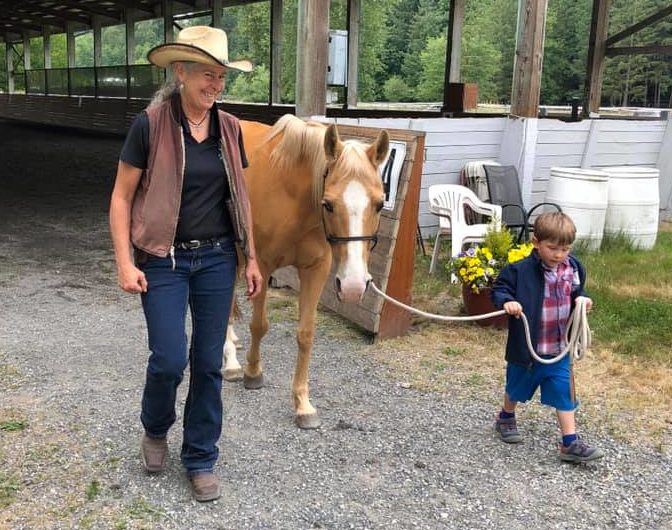
Joel Conner Clinic Update: Amelia
Amelia has been moving along steadily in her training with horsemanship volunteer Phoebe. They have been able to take thing slow and at a comfortable pace for Amelia who has had some trust issues from her past life. A few weeks prior to the clinic, Phoebe was able to sit in the saddle and Amelia did very well for a little stroll around the round pen. She was relaxed and cooperative with Phoebe aboard. While Amelia’s days of being a regular riding horse are probably behind her, it’s very possible she could be a nice leadline mare for a family with kids who want to start learning to ride.
Here is an update from Phoebe about Amelia for the recent Joel Conner Horsemanship Clinic:
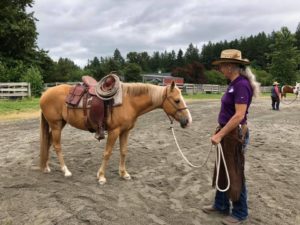 This was another breakthrough for Amelia and I. For me, more confidence with a better understanding of how the exercise Joel teaches us, translates into free feet under saddle. Her right shoulder drops inward on a unified circle, so I need to strengthen her hind so she is more balanced. She has steadily become softer but she still had a very hard time going backwards. This time, after substantial effort to resist on her part with stiff forelegs and head up, she finally gave & her feet broke free. It was a beautiful moment for both of us! She is much better at moving her front over and I am much better about knowing how/when to ask. Although I only worked with her on Friday, we got a lot done.
This was another breakthrough for Amelia and I. For me, more confidence with a better understanding of how the exercise Joel teaches us, translates into free feet under saddle. Her right shoulder drops inward on a unified circle, so I need to strengthen her hind so she is more balanced. She has steadily become softer but she still had a very hard time going backwards. This time, after substantial effort to resist on her part with stiff forelegs and head up, she finally gave & her feet broke free. It was a beautiful moment for both of us! She is much better at moving her front over and I am much better about knowing how/when to ask. Although I only worked with her on Friday, we got a lot done.
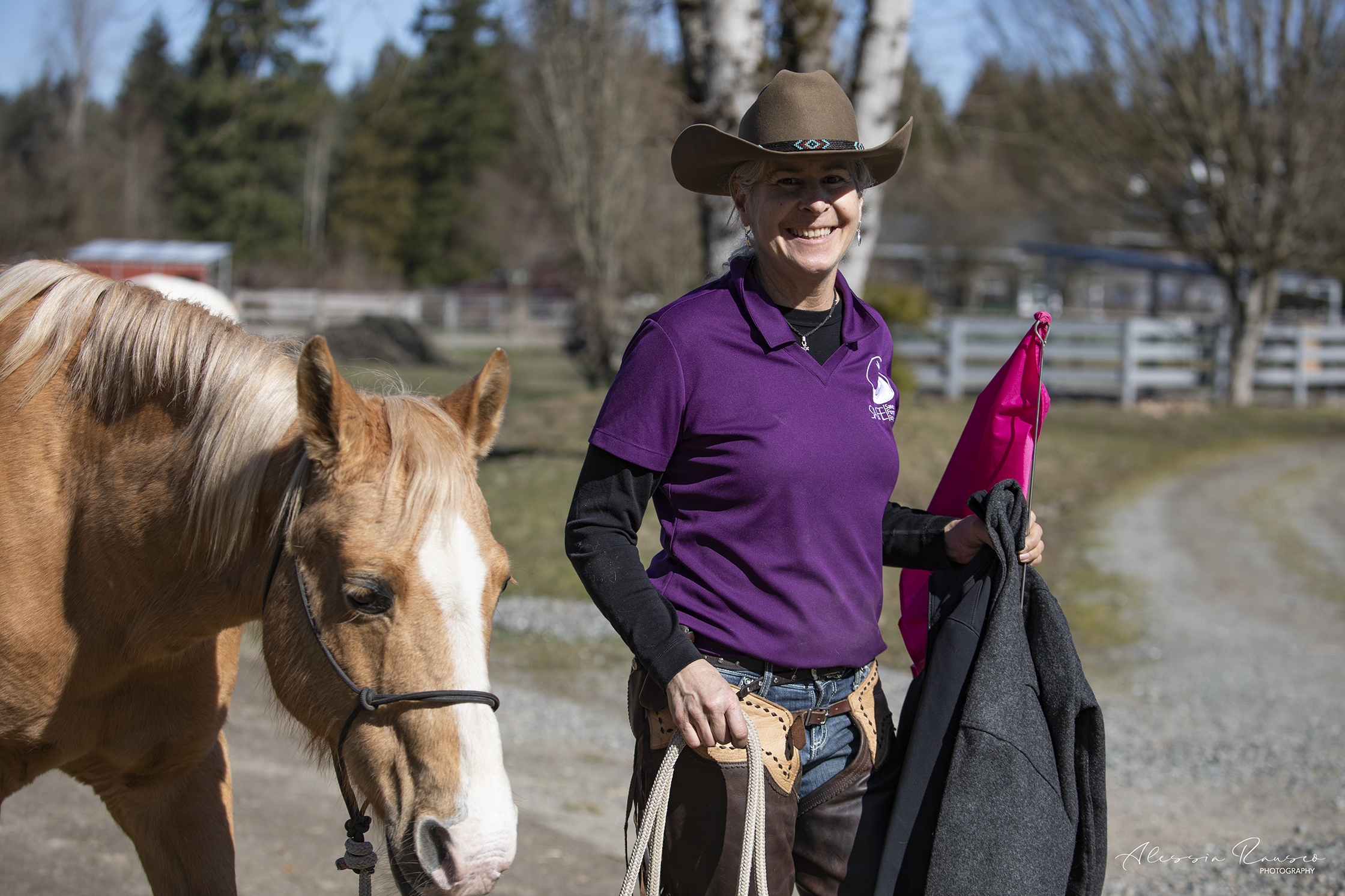
Health and Clinic Update: Amelia
Miss Amelia is doing very well at SAFE. She has a great friend for turnout in Tabitha, and her overall happiness seems to have increased. We have been working her a few times a week on the trail obstacles at Safe Harbor. Her behavior continues to improve but she still seems uneasy when tied up and groomed. If we don’t tie her, she seems a bit happier. It’s possible she had a bad experience while tied at some point in her past.
Last week we took her out and hand walked her on the trails. She really seemed to enjoy being out in the woods with her friends. She walked over the bridges and was unbothered by noisy cars, a wood chipper, bikers, and kids playing in the park.
To find out why she is still itchy during the winter months without the presence of bugs, we decided to do an allergy blood test. In addition to being allergic to flies, we found out that she is also allergic to alfalfa hay and rice bran. We have taken her off senior feed and California Trace because both contain those allergens. She eats hay but doesn’t eat enough to maintain weight, so she needs extra calories. To do this, we put her on timothy pellets and LMF Super Supplement for vitamins.
We have also been trying to help her roached back. Dr Meyer from Pilchuck has come out twice so far to help adjust her and give her more comfort. The first adjustment was difficult, and Amelia was very reactive and even kicked out during the adjustment. The second adjustment was MUCH easier, and Dr Meyer said that she had held much of the adjustment. We will be having her seen again in hopes that the muscles along her spine will have relaxed and gives her more comfort. At that time we will see if she is comfortable enough to carry a saddle and rider. It would be nice if she was happy carrying a rider for lead line or trails. She loves kids so if that is possible, she may find that to be a great future.
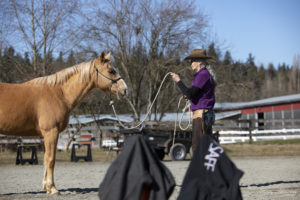 Last weekend, volunteer Phoebe took Amelia into the Horsemanship groundwork class. They have a beautiful connection and Amelia is very happy when Phoebe is working her. She still tests Phoebe from time to time, but Phoebe’s kind manner helps Amelia feel love and support. Here is what Phoebe had to say about her experience with Amelia in the clinic:
Last weekend, volunteer Phoebe took Amelia into the Horsemanship groundwork class. They have a beautiful connection and Amelia is very happy when Phoebe is working her. She still tests Phoebe from time to time, but Phoebe’s kind manner helps Amelia feel love and support. Here is what Phoebe had to say about her experience with Amelia in the clinic:
Although I only got to attend the Saturday & Sunday groundwork sessions, I don’t think it affected the strides forward that Amelia accomplished in her understanding, willingness, and skill set. She retained a good attitude with soft eyes and a willingness to try . The biggest “a‑ha” moment for me was realizing how front heavy she is, and how setting her back before beginning her next step was a big help to her, to the point that she was beginning to set herself back by the time we finished the clinic. She is starting to back in circles left and right — and staying soft, which for her is huge. Her neck was hard as a washboard 4 months ago. It is wonderful to see the partnership she is willing to offer as she builds a hesitant foundation of trust.
Amelia Health Update
Amelia has been dealing with loose stool since before her arrival at Safe Harbor Stables. It has been a frustrating trial and error endeavor to try to find the best management option for her. Our vets recommended multiple treatment options, but just when we would start to think we’d found the answer, her loose stool would return. Bloodwork and fecal tests first to rule out anything we could that way, then slow feed changes, first cutting hay versus second cutting hay versus alfalfa hay, probiotics, intestinal protectant feed additives, different probiotics, restricting fresh grass intake, the list goes on. After her loose stool went to straight diarrhea, she was prescribed metronidazole, an antibiotic and antiprotazoal medication that has an anti-inflammatory effect on the GI tract.
For a week she was on a three times daily treatment plan, which had Bonnie out at the barn to give a late PM dose each night. After her diarrhea returned after the seventh day, Dr. Fleck suggested we drop to twice daily administration for a course of 30 days. She is now at the tail end of this course of medication and her stool has been completely normal for a couple of weeks. Hopefully when she comes off of the metronidazole she will remain stabilized and that will be the end of it. Fingers crossed!
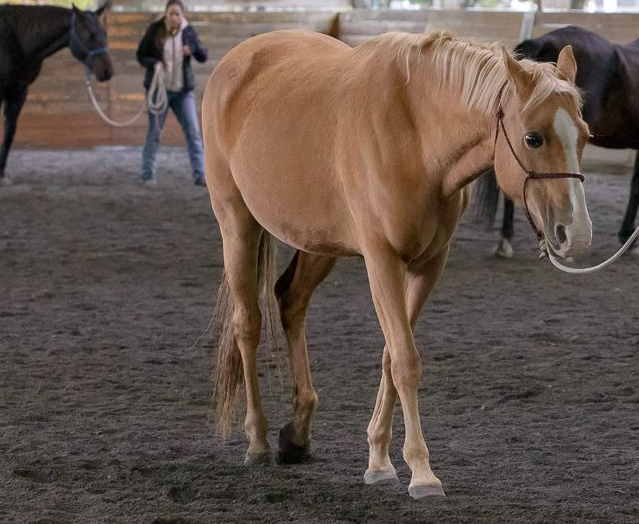
Amelia Makes Progress!
Glowing reports on Amelia’s progress from our Horsemanship Volunteer Phoebe! We will be talking with Joel Conner during this week’s clinic about his thoughts on offering her as a very light riding horse or a kids lead line. She is a sweet girl and in the right home she will be a great family member. Here is what Phoebe had to report:
Amelia — sweet, easy going but always checking to make sure she has a safe person to follow. (testing — swinging head around with intentions of possible bite, sometimes, but thinking better of it) she seems to be more aware of her handler & what they are asking — I think she might have just completely tuned out her former handler and it became habit. Learning a unified circle with nice bend both directions and still working on keeping distance equal all the way around. Better though! She is learning to follow soft feel for a one reined stop and I still think she may be a great kid’s horse.
She is starting to get softer and more responsive! We even broke into a trot to the left in the unified circle & she held good form and space for a little bit. I’m starting to get her to follow a feel into a one rein stop. Both sides. I cinched her up with the rope, and sacked her out. She did great of course. The bumps on her back are smaller. What a great kids horse she has the potential to be!
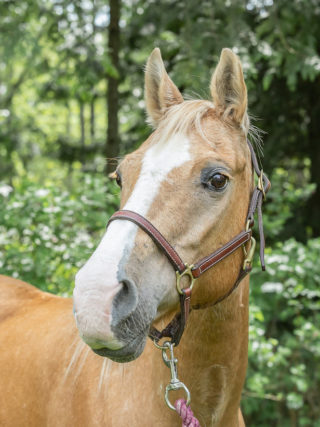
Getting to know Amelia
One of our wonderful Horsemanship volunteers, Phoebe, has been taking time to get to know Amelia. She seems like an old soul with a rough past. Her eyes are still lost…not quite ready to relax into the feeling of comfort or peace. But hopefully with all the love and extra attention from Phoebe, we’ll start to see her open up and start trusting people again. here is what Phoebe had to say about Amelia:
I have had the privilege of working with Amelia over the last couple weeks. The first time I tried to brush her she reached around as though to bite, but if I stroked her neck while brushing her belly, she totally relaxed. She is totally chill now to brushing. No bite. I’ve roped her fronts, she was fine, her right hind she kicked & protested but figured it out pretty quick and was good about me cleaning it once that was established.
She seemed very dull to human contact at first, but is becoming more aware & seems almost relieved to not have to be the alphaa anymore. She is smart, picks things up quickly, and wants to please. Her ground manners when being led are SO much better! She is learning to read me when walking on the lead, stopping, backing. Still working on the unified circle, didn’t have much chance to revisit that last week. What a calm, friendly, respectful mare she is! And what a great kids horse she could become. I can see a 4 year old loving on her, and her eating it up. Just my opinion at this stage. She is beginning to follow a feel consistently when asking for a one rein stop, both sides, is slowly learning to back up when asked, but not good at yielding her front — really dull, but not bad at yielding her hind.
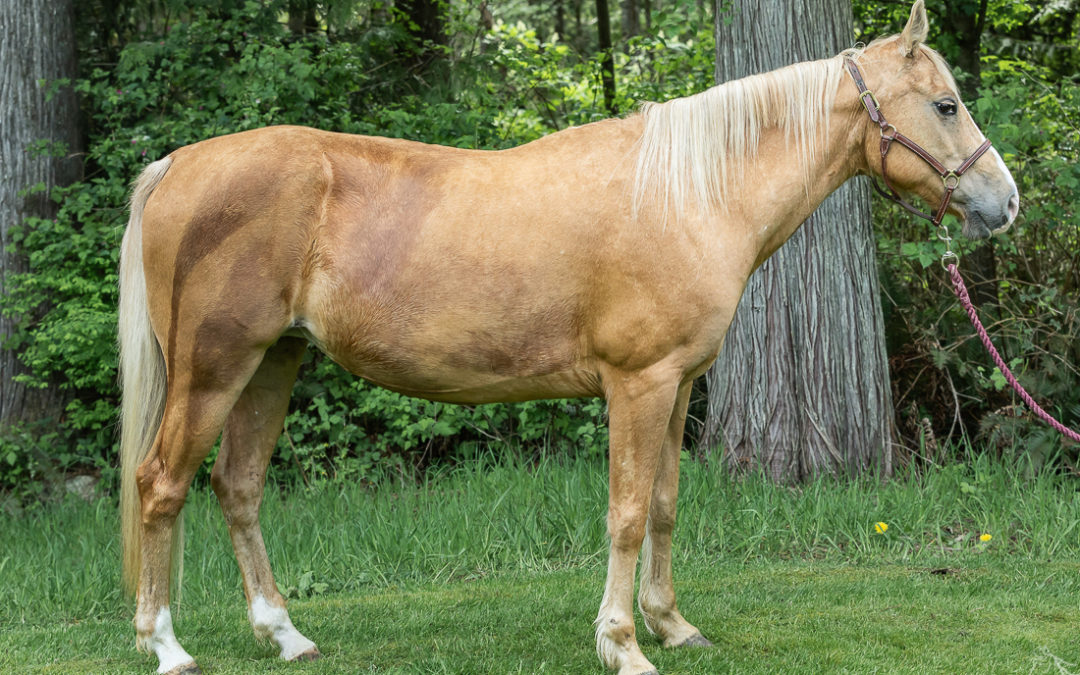
Updated Photos of Amelia
Amelia is looking much happier and prettier now that she’s enjoying some grooming and kindness. She will be going on trial for adoption as a companion horse, so fingers crossed she has a new home!!
thank you for the photos, Jessica!!
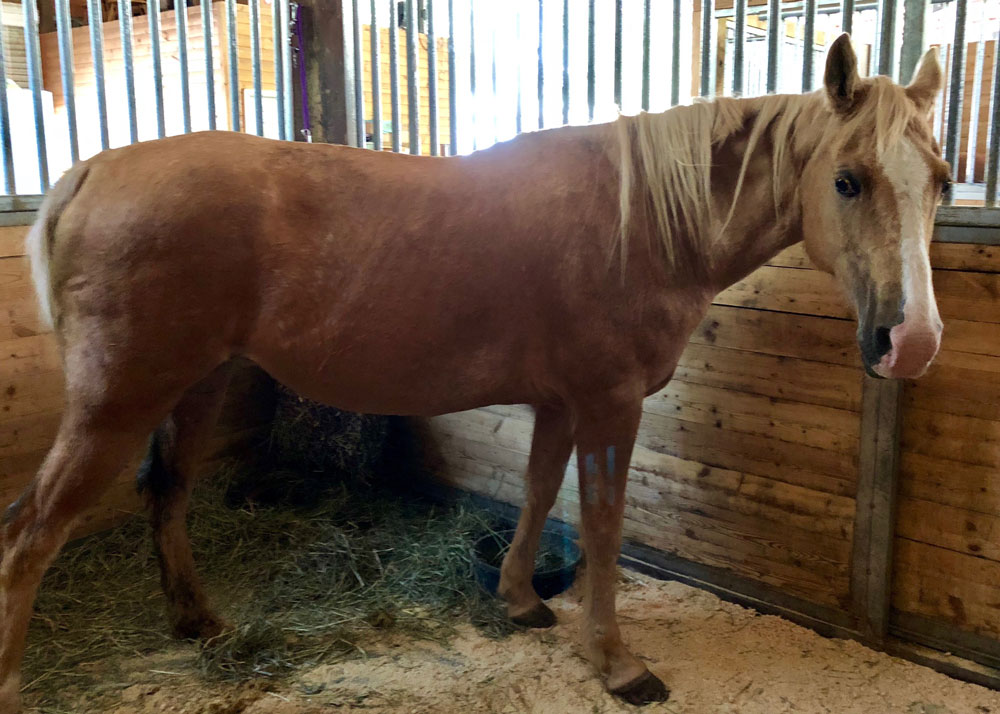
Amelia is not Pregnant
Dr Holohan, DVM from Pilchuck Vet Hospital did an examination of Amelia today and determined that she is not pregnant, but is suffering from mastitis, which is causing swelling and edema in her udder and abdomen. Amelia has been prescribed antibiotics to combat the infection, as well as stripping of built up fluids and cold hosing to relieve her discomfort. Mastitis is not very common in non-lactating mares, and can be very painful and uncomfortable. However with prompt treatment, it can usually be treated without lasting negative effects. Amelia is such a sweet mare, and she’s been living very rough for a while, so we are glad to be able to provide her with some relief and get her back to good health. We are also relieved that she is not pregnant, because at her age she deserves to take it easy and be pampered. Hopefully there is someone out there who can offer her a nice home where she will get the care she deserves.
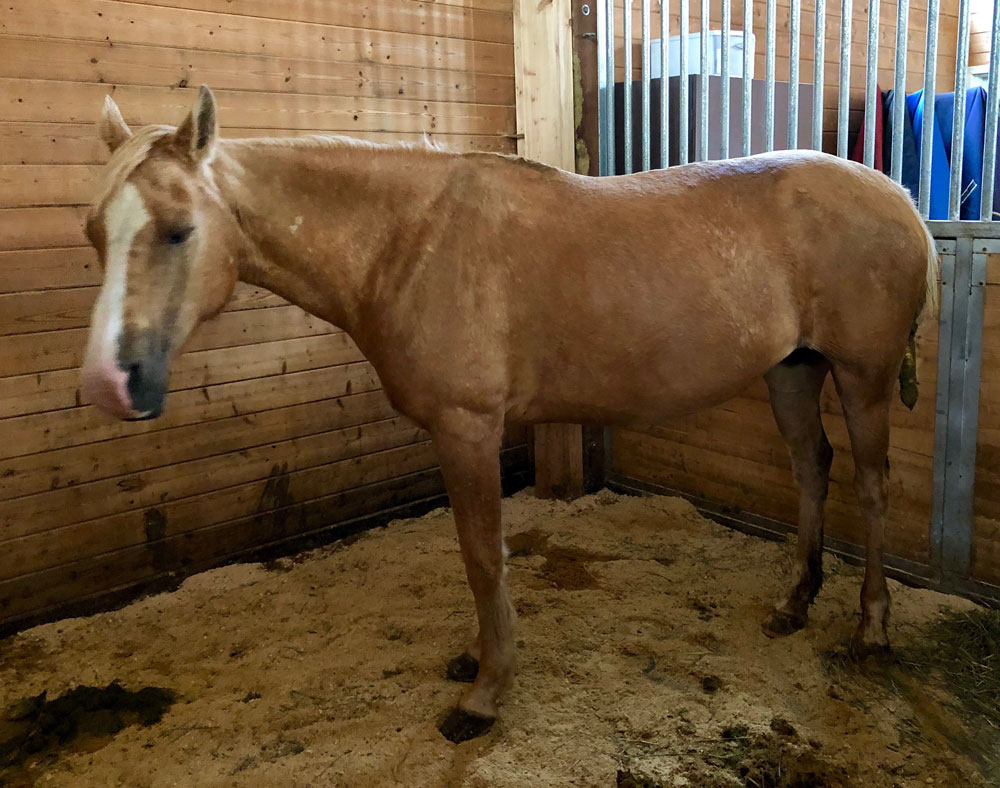
Two New Horses to Introduce
SAFE has two new intakes to introduce to the community. Both of these horses have suffered some pretty serious neglect, and both have a long road of recovery ahead of them. Fortunately, that roads lead right through Save a Forgotten Equine and our rehabilitation team!
Orion is a tall, strapping young lad, about 5–7 years old, whose body looks like he’s been through a war…covered in scrapes and cuts. He also was apparently hit or kicked in the face at some point, which resulted in a fractured lower jaw and several teeth knocked askew. He’s had surgery to remove the broken teeth as well as the impacted and infected food that built up in the space, and he’s feeling much better now. He’s also got some swelling in one of his hind legs, but x‑rays came back clean and he appears to be sound on it.
Amelia is about 18–20 years old and she’s recovering from neglect and starvation. So imagine our surprise when this sweet old girl started showing signs of being in labor! Sadly it does appear that she is pregnant although at this point we don’t know if the foal is viable or how soon she might give birth. She’s under a vet’s care, and will be examined by an equine reproductive specialist from Pilchuck later this week. She is a very sweet mare who loves to be petted and scratched. She seems quite starved for affection, and quite happy to be loved on.
It’s times like these that we are so grateful for the people whose donations to SAFE make it possible for us to take in horses like Orion and Amelia and immediately provide them with the medical attention they need. Special thanks to Dr Hannah and NWESC for their support and caring!
Orion:
Amelia:

